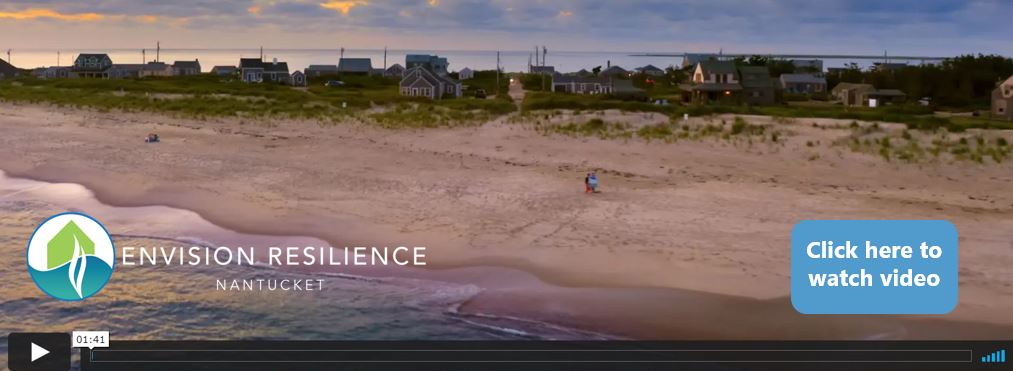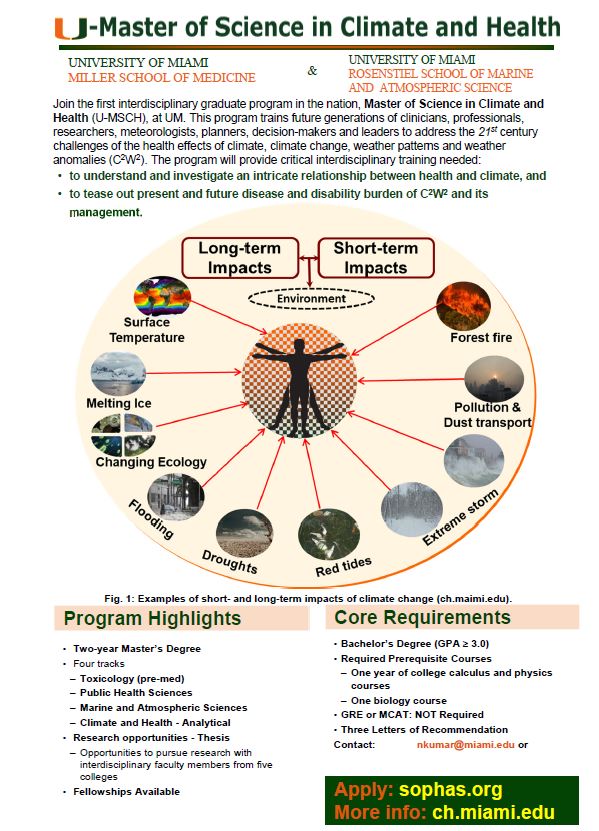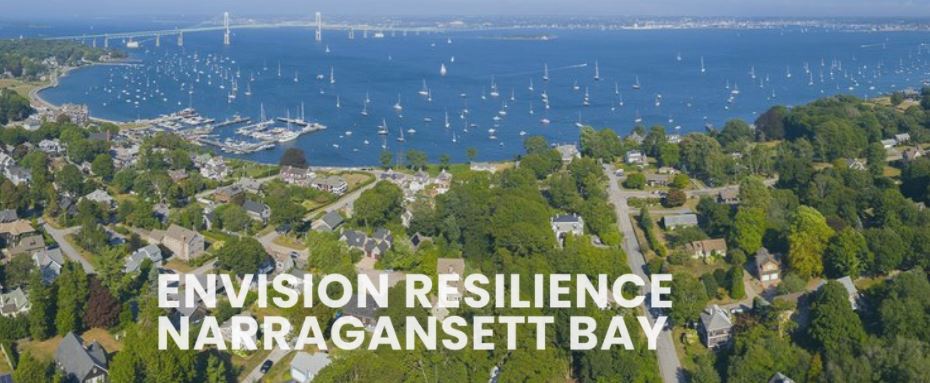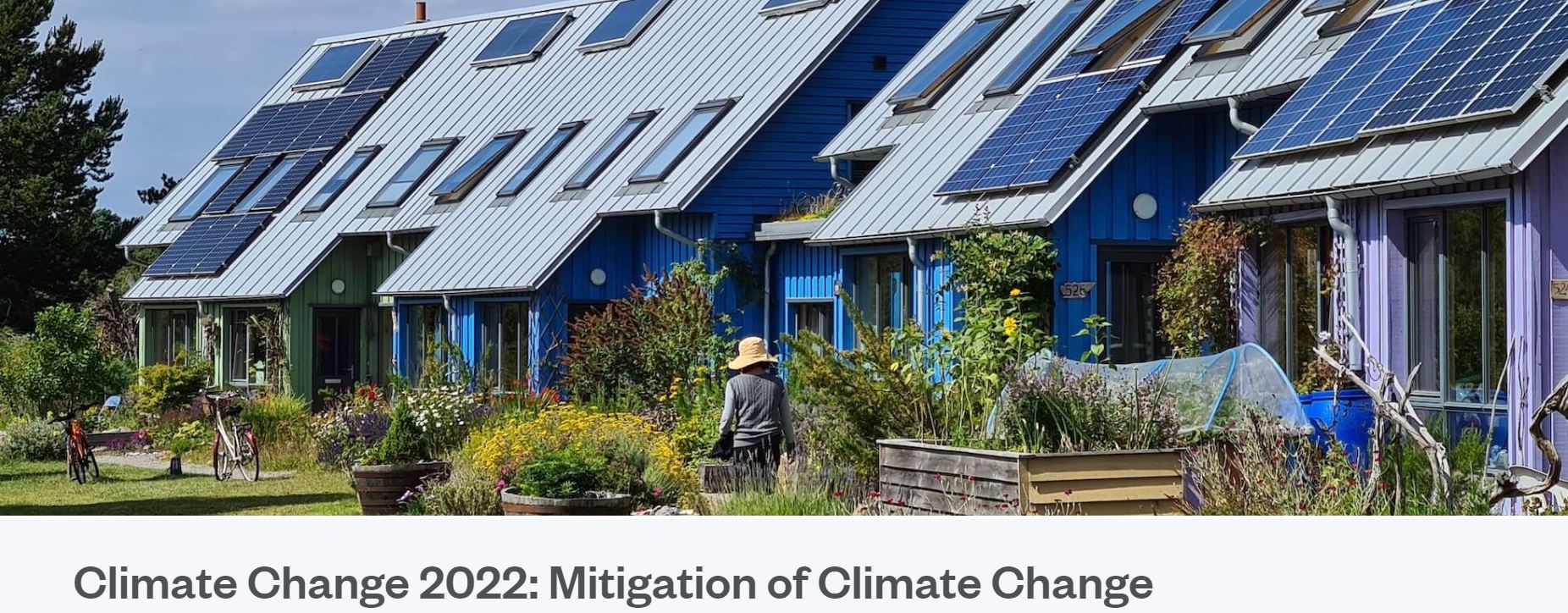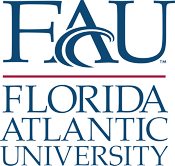News
 January 19, 2018 (Source: FSU) - New research from a Florida State University scientist has revealed a surprising relationship between surging atmospheric carbon dioxide and flower blooms in a remote tropical forest. FSU researchers studying the rich tropical forests of Panama’s Barro Colorado Island found that climbing rates of carbon dioxide have set the stage for a multidecade increase in overall flower production. The findings were outlined in a paper published in the journal Global Change Biology. “It’s really remarkable,” said Assistant Professor of Geography Stephanie Pau, who led the study. “Over the past several decades, we’ve seen temperatures warming and carbon dioxide increasing, and our study found that this tropical forest has responded to that increase by producing more flowers.”
January 19, 2018 (Source: FSU) - New research from a Florida State University scientist has revealed a surprising relationship between surging atmospheric carbon dioxide and flower blooms in a remote tropical forest. FSU researchers studying the rich tropical forests of Panama’s Barro Colorado Island found that climbing rates of carbon dioxide have set the stage for a multidecade increase in overall flower production. The findings were outlined in a paper published in the journal Global Change Biology. “It’s really remarkable,” said Assistant Professor of Geography Stephanie Pau, who led the study. “Over the past several decades, we’ve seen temperatures warming and carbon dioxide increasing, and our study found that this tropical forest has responded to that increase by producing more flowers.”
 January 22, 2018 (Source: FAU) - Alarming results from a recent gender ratio study revealed that 99 percent of young green turtles from Australia’s Northern Great Barrier Reef are female and that male sea turtles are disappearing. Closer to home, researchers from Florida Atlantic University have documented a similar trend in sea turtle hatchlings in southeast Florida. Since 2002, they have studied sea turtles in Palm Beach County and discovered that 97 to 100 percent of the hatchlings have been female. In a study published in Zoology , FAU researchers are the first to show why and how moisture conditions inside the nest affect the development and sex ratios of turtle embryos. They are the first to estimate sex ratios using a male-specific, transcriptional molecular marker Sox9, a marker of testis development in sea turtles and freshwater turtles. The researchers found that the coolest and the wettest substrates produce 100 percent males compared to 42 percent males from the warmest and driest treatment. They also found that embryonic growth appears to be more sensitive to temperature at earlier stages of development and to moisture at later stages. “During incubation, the turtle embryo grows inside the nest from a few cells to a fully formed and independent organism at hatching,” said Jeanette Wyneken, Ph.D., author of the study and a professor of biological sciences in FAU’s Charles E. Schmidt College of Science. “For proper development, embryos require an appropriate range of temperature, moisture, salinity, and respiratory gases.”
January 22, 2018 (Source: FAU) - Alarming results from a recent gender ratio study revealed that 99 percent of young green turtles from Australia’s Northern Great Barrier Reef are female and that male sea turtles are disappearing. Closer to home, researchers from Florida Atlantic University have documented a similar trend in sea turtle hatchlings in southeast Florida. Since 2002, they have studied sea turtles in Palm Beach County and discovered that 97 to 100 percent of the hatchlings have been female. In a study published in Zoology , FAU researchers are the first to show why and how moisture conditions inside the nest affect the development and sex ratios of turtle embryos. They are the first to estimate sex ratios using a male-specific, transcriptional molecular marker Sox9, a marker of testis development in sea turtles and freshwater turtles. The researchers found that the coolest and the wettest substrates produce 100 percent males compared to 42 percent males from the warmest and driest treatment. They also found that embryonic growth appears to be more sensitive to temperature at earlier stages of development and to moisture at later stages. “During incubation, the turtle embryo grows inside the nest from a few cells to a fully formed and independent organism at hatching,” said Jeanette Wyneken, Ph.D., author of the study and a professor of biological sciences in FAU’s Charles E. Schmidt College of Science. “For proper development, embryos require an appropriate range of temperature, moisture, salinity, and respiratory gases.”
(Photo credit: Jay Paredes)
 February 5, 2018 (Source: USF) - Researchers at the University of South Florida have offered a deeper understanding of climate change effects on animal phenology in their study, "A global synthesis of animal phenological responses to climate change", published this week in Nature Climate Change.
February 5, 2018 (Source: USF) - Researchers at the University of South Florida have offered a deeper understanding of climate change effects on animal phenology in their study, "A global synthesis of animal phenological responses to climate change", published this week in Nature Climate Change.
By examining more than a thousand records of these phenological shifts dating back to the 1950s, the study revealed that various taxa, like insects, birds, amphibians and mammals, are shifting their seasonal activities at different rates in response to a changing climate.
“We found that cold-blooded species and those with small body sizes are shifting their phenological activities faster, or track changing climates more effectively, than warm-blooded or large-bodied species,” said the study’s lead author Jeremy Cohen, PhD, a postdoctoral researcher in the USF Department of Integrative Biology. “These differences could potentially cause mismatches between interacting species, such as migrating birds and their prey.”
The study also provides the first evidence that different locations have different drivers of climate change-induced phenological shifts. For example, at temperate latitudes, multidecadal trends in temperature were associated with phenological shifts, whereas at tropical latitudes, it was trends in precipitation. Jason Rohr, PhD, a USF professor and co-author of the study, explained that these patterns are sensible because seasonality is generally driven by temperature in temperate regions and rainfall in tropical regions.
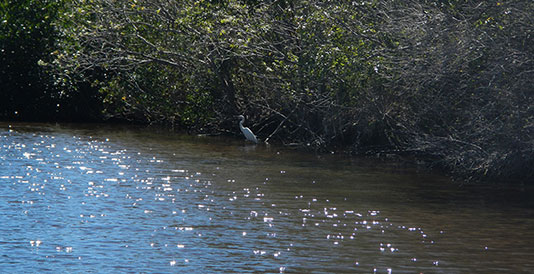 February 5, 2018 (Source: FIU) - As sea levels continue to rise, more areas of the coastal Everglades will be susceptible to salt water intrusion, according to a new FIU study.
February 5, 2018 (Source: FIU) - As sea levels continue to rise, more areas of the coastal Everglades will be susceptible to salt water intrusion, according to a new FIU study.
Sea levels rose 2.2 centimeters annually from 2011 to 2015, according to scientists in FIU’s Southeast Environmental Research Center and FIU’s Sea Level Solutions Center. In 2012, sea levels rose 10 centimeters in the dry season months of December to May and have not subsided. Many factors contributed to the drastic increase in 2012, including melting ice sheets, a strong La Niña season in 2011, and slow ocean currents that allowed sea water to pile up along coastlines. Parts of the coastal Everglades that were once flooded by sea water about 70 percent of the time are now covered by sea water 90 percent of the time.
“Salt water intrudes farther inland when there is a small difference between Everglades fresh water levels and sea level,” said Shimelis Dessu, postdoctoral research associate in the Southeast Environmental Research Center and lead author of the paper. “Salinity is an indicator of the coastal Florida Everglades’ health.”
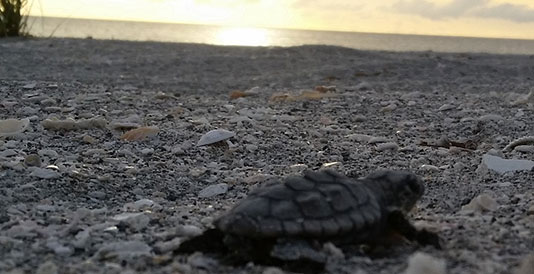 February 8, 2018 (Source: FAU) - Who’s your daddy? No, it’s not a TV clip from “The Jerry Springer Show” to identify who the “real” father is. Rather, it is a groundbreaking study of sea turtle nests and hatchlings using paternity tests to uncover “who are your daddies?”
February 8, 2018 (Source: FAU) - Who’s your daddy? No, it’s not a TV clip from “The Jerry Springer Show” to identify who the “real” father is. Rather, it is a groundbreaking study of sea turtle nests and hatchlings using paternity tests to uncover “who are your daddies?”
The study conducted by researchers at Florida Atlantic University and published in PLOS One , is the first to document multiple paternity in loggerhead sea turtle nests in southwest Florida. What started out as a study on female sea turtle promiscuity – females can have multiple partners and can store sperm for more than three months after mating events – is proving to be very good news for this female-biased species facing rising risks of extinction due to climate change.
Due to their accessibility, nesting female sea turtles, nest success, and hatchlings are frequently examined and used for demographic studies and population models (key areas for the management of imperiled species). Yet, there is very limited understanding of the proportion of adult males and males approaching sexual maturity in any sea turtle population. Consequently, male sea turtles’ reproductive behavior is poorly understood and adult sex ratio cannot be estimated directly.
“Studying sex ratios of adult sea turtles in the ocean is logistically difficult because they are widely distributed and males are especially difficult to access because they rarely come to land,” said Jacob Lasala, corresponding author of the study and a Ph.D. student working with Jeanette Wyneken, Ph.D., co-author and a professor in the Department of Biological Sciences at FAU’s Charles E. Schmidt College of Science. “We decided to use a different approach and measure ‘breeding sex ratios’ using genotyping to examine the number of male sea turtles that contribute to nests.”
 February 12, 2018 (Source: USF) - Twenty-five years of satellite data prove climate models are correct in predicting that sea levels will rise at an increasing rate. In a new study published in the journal Proceedings of the National Academy of Sciences, researchers found that since 1993, ocean waters have moved up the shore by almost 1 millimeter per decade. That’s on top of the 3 millimeter steady annual increase. This acceleration means we’ll gain an additional millimeter per year for each of the coming decades, potentially doubling what would happen to the sea level by 2100 if the rate of increase was constant.
February 12, 2018 (Source: USF) - Twenty-five years of satellite data prove climate models are correct in predicting that sea levels will rise at an increasing rate. In a new study published in the journal Proceedings of the National Academy of Sciences, researchers found that since 1993, ocean waters have moved up the shore by almost 1 millimeter per decade. That’s on top of the 3 millimeter steady annual increase. This acceleration means we’ll gain an additional millimeter per year for each of the coming decades, potentially doubling what would happen to the sea level by 2100 if the rate of increase was constant.
“The acceleration predicted by the models has now been detected directly from the observations. I think this is a game-changer as far as the climate change discussion goes,” said co-author Gary Mitchum, PhD, associate dean and professor at the University of South Florida College of Marine Science. “For example, the Tampa Bay area has been identified as one of 10 most vulnerable areas in the world to sea level rise and the increasing rate of rise is of great concern.”
February 21, 2018 (Source: American Institute of Biological Sciences via ScienceDaily) - The linkages between environmental health and human well-being are complex and dynamic, and researchers have developed numerous models and theories for describing them. They include attempts to bridge traditional academic boundaries, uniting fields of study under rubrics such as social-ecological frameworks, coupled human and natural systems, ecosystem services, and resilience theory. However, these efforts have been constrained by varying practices and a failure among practitioners to agree on consistent practices.
Writing in BioScience , Jiangxiao Qiu of the University of Florida and his colleagues describe this state of affairs and propose an alternative and practical approach to understanding the interplay of social and ecological spheres: causal chains. The authors describe these chains as an "approach to identifying logical and ordered sequences of effects on how a system responds to interventions, actions, or perturbations." And although causal chains are well established in many fields, the authors highlight that "there is no normative consensus about the principles and guidelines necessary to create causal chains relevant for dealing with human-nature challenges."
By refining and standardizing the causal chain methodology, the authors hope that the drivers of human behavior, and inherently linked social and ecological outcomes can be better understood -- and then acted on. For instance, the authors cite an example of a biophysical system in Kenya in which forests are converted to farmland without the supply of additional nutrients. Without intervention, the consequent soil degradation then results in "food insecurity and reduced household income, while further accelerating the degradation of the remaining forests."
By viewing this cycle through the lens of causal chains, managers might be better able to see ways to break it. Qiu and his colleagues describe a three-phase system for identifying and working with causal chains, designed to permit the assessment of current systems and their responses to management actions. Possible targets for study include food production and pollution interactions, land-use change and its effects on local populations, and the responses of natural and social communities to climate-change-induced severe weather events.
 March 14, 2018 (Source: 100 Resilient Cities) - 100 Resilient Cities – Pioneered by The Rockefeller Foundation today released “Safer and Stronger Cities,” a series of policy recommendations for the federal government to help our nation’s urban centers become more resilient in the face of 21st-century challenges. The report, which comes after cities faced an unprecedented series of short-term and long-term challenges in 2017, focuses its recommendations on infrastructure, housing, flood insurance, economic development, and public safety.
March 14, 2018 (Source: 100 Resilient Cities) - 100 Resilient Cities – Pioneered by The Rockefeller Foundation today released “Safer and Stronger Cities,” a series of policy recommendations for the federal government to help our nation’s urban centers become more resilient in the face of 21st-century challenges. The report, which comes after cities faced an unprecedented series of short-term and long-term challenges in 2017, focuses its recommendations on infrastructure, housing, flood insurance, economic development, and public safety.
Access the full report here: www.100resilientcities.org/safer-and-stronger
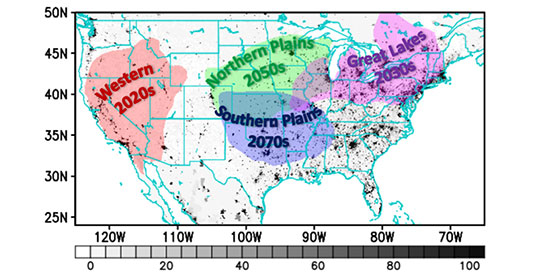 March 19, 2018 (Source: UM/RSMAS) Human-caused climate change will drive more extreme summer heat waves in the western U.S., including in California and the Southwest as early as 2020, new research shows. The new analysis of heat wave patterns across the U.S., led by scientists at the University of Miami Rosenstiel School of Marine and Atmospheric Science (UM) based Cooperative Institute for Marine and Atmospheric Science (CIMAS) and colleagues, also found that man-made climate change will be a dominant driver for heat wave occurrences in the Great Lakes region by 2030, and in the Northern and Southern Plains by 2050 and 2070, respectively.
March 19, 2018 (Source: UM/RSMAS) Human-caused climate change will drive more extreme summer heat waves in the western U.S., including in California and the Southwest as early as 2020, new research shows. The new analysis of heat wave patterns across the U.S., led by scientists at the University of Miami Rosenstiel School of Marine and Atmospheric Science (UM) based Cooperative Institute for Marine and Atmospheric Science (CIMAS) and colleagues, also found that man-made climate change will be a dominant driver for heat wave occurrences in the Great Lakes region by 2030, and in the Northern and Southern Plains by 2050 and 2070, respectively.
Man-made climate change is the result of increased carbon dioxide and other human-made emissions into the atmosphere.
“These are the years that the human contributions to climate change will become as important as natural variability in causing heat waves,” said lead author Hosmay Lopez, a CIMAS meteorologist based at NOAA’s Atlantic Oceanographic Meteorological Laboratory. “Without human influence, half of the extreme heat waves projected to occur during this century wouldn’t happen.”
The study, published in the March 19, 2018 online issue of the journal Nature Climate Change, has important implications for the growing populations in these regions since heat waves, which are the number one cause of weather-related deaths in the United States, have already increased in number and severity in recent decades and are projected to rise well into the 21st century.
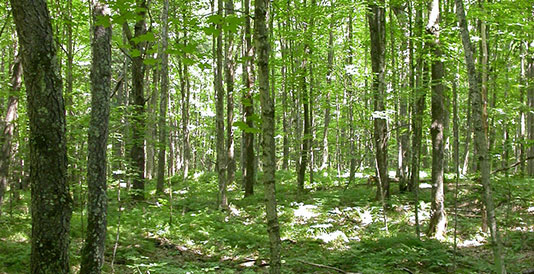 March 21, 2018 (Source: UF) - The face of American forests is changing, thanks to climate change-induced shifts in rainfall and temperature that are causing shifts in the abundance of numerous tree species, according to a new paper by University of Florida researchers.
March 21, 2018 (Source: UF) - The face of American forests is changing, thanks to climate change-induced shifts in rainfall and temperature that are causing shifts in the abundance of numerous tree species, according to a new paper by University of Florida researchers.
The result means some forests in the eastern U.S. are already starting to look different, but more important, it means the ability of those forests to soak up carbon is being altered as well, which could in turn bring about further climate change.
“Although climate change has been less dramatic in the eastern U.S. compared to some other regions, such as Alaska and the southwestern U.S., we were interested to see if there were signals in forest inventory data that might indicate climate-induced changes in eastern U.S. forests,” said Jeremy Lichstein, senior author and a UF assistant professor of biology. “The changes we documented are easily masked by other disturbances, which is probably why no one had previously documented them. Without a long-term dataset with millions of trees, we probably could not have detected these changes.”
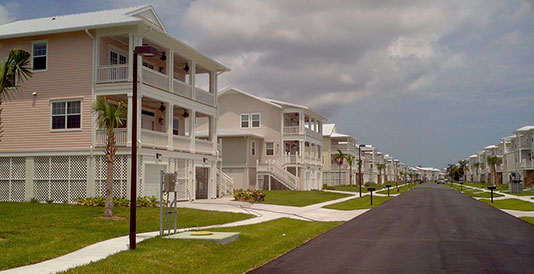 March 22, 2018 (Source: UM CAS) - Conservationists and natural resource managers have lost ground over the past 20 years as more and more natural land—especially on the coast—has given way to homes and businesses, threatening the natural ecosystem.
March 22, 2018 (Source: UM CAS) - Conservationists and natural resource managers have lost ground over the past 20 years as more and more natural land—especially on the coast—has given way to homes and businesses, threatening the natural ecosystem.
University of Miami Associate Professor in Biology Kathleen Sullivan Sealey and her colleagues set out to find out why by investigating the ecology of finance and the financial innovations that have facilitated rapid housing development.
In a study published in the journal Anthropocene entitled, “Financial credit drives urban land-use change in the United States,” Sealey and her team borrowed concepts from ecology, finance, urban studies, and complex systems to develop a hypothesis about the fundamental shifts in the flow of money throughout the entire development and construction process.
The paper lays the foundation for a new area of research in the coupled human-natural systems linking modern finance to climate and ecological change.
“After three years of research that included a case study specific for South Florida, we found that the greatest attribute for the housing boom, from 1980 to 2008, was the key changes in banking regulations in the 1970s that allowed for increased availability of credit,” said Sealey. “The key component was the ability to transfer investment risks for developers and lending institutions.”
 March 27, 2018 (Source: FIU) - Seagrasses in Shark Bay, Australia released massive amounts of carbon dioxide after a devastating heat wave killed them, according to a new study.
March 27, 2018 (Source: FIU) - Seagrasses in Shark Bay, Australia released massive amounts of carbon dioxide after a devastating heat wave killed them, according to a new study.
More than 22 percent of Shark Bay’s seagrasses died when water temperatures warmed as much as 7 degrees Fahrenheit above normal for more than two months in 2011. Up to 9 million metric tons of carbon dioxide were released — the equivalent of what is released annually by 800,000 homes or 1.6 million cars. Healthy seagrass meadows act as giant reservoirs that store carbon in their soils, leaves and other organic matter.
“As the Earth’s climate changes, we expect to see more and more intense heat waves,” said James Fourqurean, director of FIU’s Center for Coastal Oceans Research and co-author of the study. “This release of carbon to the atmosphere as carbon dioxide will only cause further heating of the atmosphere, heating of the oceans and climate change.”
 March 30, 2018 (Source: FIU) - Small-scale droughts can have big effects on the Florida Everglades. Ph.D. student Anteneh Abiy is digging deep into these abnormally low rainfall events. He doesn’t have to do go too far into weather data to begin his work. 2017 was drier than usual. The Everglades received 6 inches of rainfall less than the annual average.
March 30, 2018 (Source: FIU) - Small-scale droughts can have big effects on the Florida Everglades. Ph.D. student Anteneh Abiy is digging deep into these abnormally low rainfall events. He doesn’t have to do go too far into weather data to begin his work. 2017 was drier than usual. The Everglades received 6 inches of rainfall less than the annual average.
Fresh water in the Everglades feeds into the Biscayne Aquifer, the main water supply for Broward, Miami-Dade, Monroe and Palm Beach counties. Small-scale drought events have cropped up over the past two decades, leaving lasting impacts on the county’s water supply.
“Drought is a cancer. Its effects creep up little by little and you don’t notice them until it’s too late,” Abiy said. “You can’t predict when drought will happen. But, with the right information, you can design sound strategies to better store water in the Everglades, manage our water supply and take action immediately.”
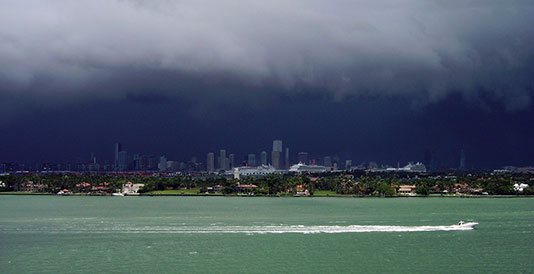 April 9, 2018 (Source: FSU) - New research from Florida State University scientists has found that urban areas throughout the Florida peninsula are experiencing shorter, increasingly intense wet seasons relative to underdeveloped or rural areas.
April 9, 2018 (Source: FSU) - New research from Florida State University scientists has found that urban areas throughout the Florida peninsula are experiencing shorter, increasingly intense wet seasons relative to underdeveloped or rural areas.
The study, published in the Nature Partner Journal Climate and Atmospheric Science, provides new insight into the question of land development’s effect on seasonal climate processes.
Using a system that indexed urban land cover on a scale of one to four — one being least urban and four being most urban — the researchers mapped the relationship between land development and length of wet season.
“What we found is a trend of decreasing wet-season length in Florida’s urban areas compared to its rural areas,” said Vasu Misra, associate professor of Earth, Ocean and Atmospheric Science and lead investigator of the study.
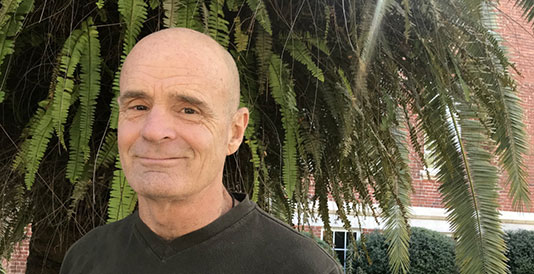 April 16, 2018 (Source: UF) - University of Florida history professor Jack E. Davis is the winner of the 2018 Pulitzer Prize in History for his book “The Gulf: The Making of an American Sea,” the Pulitzer Prize Board announced today. “The Gulf” also won the Kirkus Prize, was a finalist for the National Book Critics Circle Award, was a New York Times Notable Book, and made a number of other “best of” lists in national publications. When Davis first conceived of “The Gulf,” the Deepwater Horizon accident that dumped 130 million gallons of oil into the Gulf of Mexico had not yet happened. That Davis was writing a history of the Gulf around the same time as the largest oil spill in history was coincidental, and allowed him to focus on aspects other than the spill, which he says, “seemed to rob the Gulf of Mexico of its true identity. I wanted to restore it, to show people that the Gulf is more than an oil spill,” he said. “It’s got a rich, natural history connected to Americans, and it’s not integrated into the larger American historical narrative. That’s a wrong I wanted to correct.”
April 16, 2018 (Source: UF) - University of Florida history professor Jack E. Davis is the winner of the 2018 Pulitzer Prize in History for his book “The Gulf: The Making of an American Sea,” the Pulitzer Prize Board announced today. “The Gulf” also won the Kirkus Prize, was a finalist for the National Book Critics Circle Award, was a New York Times Notable Book, and made a number of other “best of” lists in national publications. When Davis first conceived of “The Gulf,” the Deepwater Horizon accident that dumped 130 million gallons of oil into the Gulf of Mexico had not yet happened. That Davis was writing a history of the Gulf around the same time as the largest oil spill in history was coincidental, and allowed him to focus on aspects other than the spill, which he says, “seemed to rob the Gulf of Mexico of its true identity. I wanted to restore it, to show people that the Gulf is more than an oil spill,” he said. “It’s got a rich, natural history connected to Americans, and it’s not integrated into the larger American historical narrative. That’s a wrong I wanted to correct.”
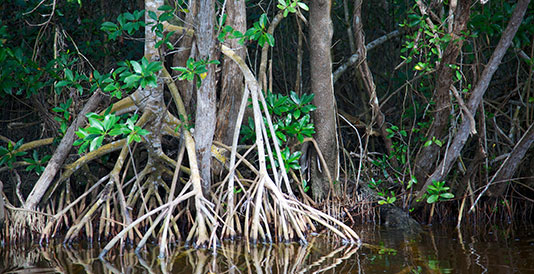 April 30, 2018 (Source: FIU) - Mangroves running for their lives may have just hit the end of the road. The problem is so clear, it might be the first real sign Earth has entered a new geological era. Using a combination of aerial photographs from the 1930s, modern satellite imagery and ground sediment samples, FIU Sea Level Solutions Center researchers Randall W. Parkinson and John F. Meeder tracked the mangroves’ westward retreat from the coastal Everglades. Now, their backs are to the wall – literally. Having reached the L-31E levee in southeast Miami-Dade County, there’s nowhere left for mangroves in that part of the Everglades to flee. "You can see migration westward has stopped right where that levee is," Parkinson said. "In many cases there no space for them to migrate into — there’s development or some feature that blocks their migration. They’re done. That’s it."
April 30, 2018 (Source: FIU) - Mangroves running for their lives may have just hit the end of the road. The problem is so clear, it might be the first real sign Earth has entered a new geological era. Using a combination of aerial photographs from the 1930s, modern satellite imagery and ground sediment samples, FIU Sea Level Solutions Center researchers Randall W. Parkinson and John F. Meeder tracked the mangroves’ westward retreat from the coastal Everglades. Now, their backs are to the wall – literally. Having reached the L-31E levee in southeast Miami-Dade County, there’s nowhere left for mangroves in that part of the Everglades to flee. "You can see migration westward has stopped right where that levee is," Parkinson said. "In many cases there no space for them to migrate into — there’s development or some feature that blocks their migration. They’re done. That’s it."
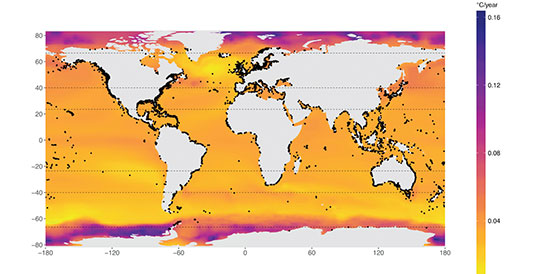 May 8, 2018 (Source: UNC/ScienceDaily) - New research found that most marine life in Marine Protected Areas will not be able to tolerate warming ocean temperatures caused by greenhouse gas emissions. The study found that with continued 'business-as-usual' emissions, the protections currently in place won't matter, because by 2100, warming and reduced oxygen concentration will make Marine Protected Areas uninhabitable by most species currently residing in those areas. "There has been a lot of talk about establishing marine reserves to buy time while we figure out how to confront climate change," said Rich Aronson, ocean scientist at Florida Institute of Technology and a researcher on the study. "We're out of time, and the fact is we already know what to do: We have to control greenhouse gas emissions."
May 8, 2018 (Source: UNC/ScienceDaily) - New research found that most marine life in Marine Protected Areas will not be able to tolerate warming ocean temperatures caused by greenhouse gas emissions. The study found that with continued 'business-as-usual' emissions, the protections currently in place won't matter, because by 2100, warming and reduced oxygen concentration will make Marine Protected Areas uninhabitable by most species currently residing in those areas. "There has been a lot of talk about establishing marine reserves to buy time while we figure out how to confront climate change," said Rich Aronson, ocean scientist at Florida Institute of Technology and a researcher on the study. "We're out of time, and the fact is we already know what to do: We have to control greenhouse gas emissions."
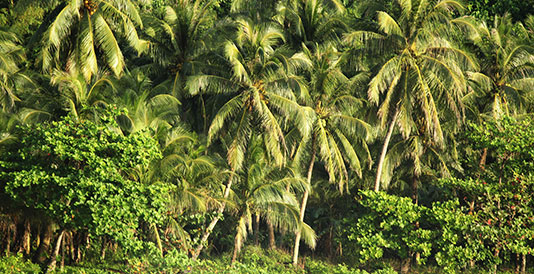 May 29, 2018 (Source: Jack Putz) - A recently published paper in Global Change Biology discusses how tropical forests provide critical ecosystem services for life on Earth including climate protection by storing large amounts of carbon. One big challenge is that these forests are located in poor countries where improvement of human livelihoods is paramount. The study, led by researchers from Boise State University, sheds light on how to balance timber production and carbon storage in tropical forests. The researchers used field data and mathematical models to determine thresholds for logging intensity, after which tropical forests managed for timber begin to lose their ability to recover their carbon stocks and supply timber. The focus on timber stand management is warranted by the fact that half of all remaining tropical forests are being logged.
May 29, 2018 (Source: Jack Putz) - A recently published paper in Global Change Biology discusses how tropical forests provide critical ecosystem services for life on Earth including climate protection by storing large amounts of carbon. One big challenge is that these forests are located in poor countries where improvement of human livelihoods is paramount. The study, led by researchers from Boise State University, sheds light on how to balance timber production and carbon storage in tropical forests. The researchers used field data and mathematical models to determine thresholds for logging intensity, after which tropical forests managed for timber begin to lose their ability to recover their carbon stocks and supply timber. The focus on timber stand management is warranted by the fact that half of all remaining tropical forests are being logged.
The study was based on over two decades of data from Guyana, a biodiverse country that is globally important as a forest carbon reservoir. The results provide novel insights into logging practices compatible with maintenance of the carbon and timber values of these forests. The researchers found that recovery rates of forests after logging, even with the application of the highest standards of logging practices known as reduced-impact logging (RIL), depends on the presence of old growth. Overall, the benefits of RIL diminish at high logging intensities. An additional experimental treatment, the liberation from competition of small commercial trees, successfully increased timber yields but the forest stored 20% less carbon.
Professor Jack Putz from the University of Florida, the senior collaborator on the study, pointed out major challenges for tropical forest management are identification of logging intensity thresholds and development of post-harvest treatments that are compatible with maintenance of ecosystem services. “Our study highlights the importance of remnant old-growth trees and the consequences of management intensification. Success at intensification may allow forest managers to meet societal needs for timber in smaller areas, albeit at the cost of other ecosystem services such as carbon and biodiversity in these areas. But intensification may also spare more pristine forests from disturbances associated with logging.”
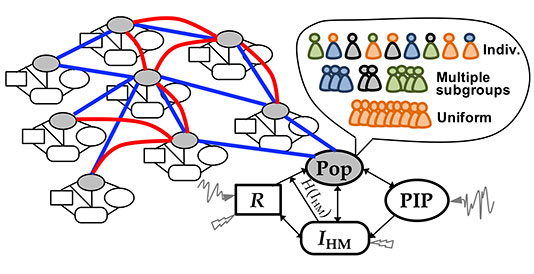 May 30, 2018 (Source: UF/ABE) - Researchers from the University of Florida, Columbia University, and East Carolina University have been awarded a grant from the US Department of Defense for a project titled, "Towards a Multi-Scale Theory on Coupled Human Mobility and Environmental Change." The project will be led by Rachata Muneepeerakul from UF's Department of Agricultural and Biological Engineering. The results of this project will provide interested DoD entities an enhanced ability to anticipate and predict population movements resulting from environmental changes, including a development of a more effective migration early warning system. Such ability will help foster better logistical responses on the part of DoD to any given event or sets of events.
May 30, 2018 (Source: UF/ABE) - Researchers from the University of Florida, Columbia University, and East Carolina University have been awarded a grant from the US Department of Defense for a project titled, "Towards a Multi-Scale Theory on Coupled Human Mobility and Environmental Change." The project will be led by Rachata Muneepeerakul from UF's Department of Agricultural and Biological Engineering. The results of this project will provide interested DoD entities an enhanced ability to anticipate and predict population movements resulting from environmental changes, including a development of a more effective migration early warning system. Such ability will help foster better logistical responses on the part of DoD to any given event or sets of events.
 May 31, 2018 (Source: FIU) - Jayantha Obeysekera has been named director of the FIU Sea Level Solutions Center. He will lead the research, education and outreach hub designed to develop and implement solutions for the impacts caused by one of the greatest threats facing Florida today — rising seas. Founding Director Tiffany Troxler has been named director of science. As director, Obeysekera will focus on developing national and international collaborations, expanding research initiatives and assisting local and regional governments with adaptation and resilience. The center is a key program in FIU’s Institute of Water and Environment. “The Sea Level Solutions Center at FIU has a tremendous potential to be a national center of excellence for sea level rise research,” Obeysekera said. “It is a hub where expert faculty and students at FIU can collaborate with national and international partners to build resiliency to communities in South Florida and elsewhere.”
May 31, 2018 (Source: FIU) - Jayantha Obeysekera has been named director of the FIU Sea Level Solutions Center. He will lead the research, education and outreach hub designed to develop and implement solutions for the impacts caused by one of the greatest threats facing Florida today — rising seas. Founding Director Tiffany Troxler has been named director of science. As director, Obeysekera will focus on developing national and international collaborations, expanding research initiatives and assisting local and regional governments with adaptation and resilience. The center is a key program in FIU’s Institute of Water and Environment. “The Sea Level Solutions Center at FIU has a tremendous potential to be a national center of excellence for sea level rise research,” Obeysekera said. “It is a hub where expert faculty and students at FIU can collaborate with national and international partners to build resiliency to communities in South Florida and elsewhere.”
 June 11, 2018 (Source: FSU) - Global climate change, fueled by skyrocketing levels of atmospheric carbon dioxide, is siphoning oxygen from today’s oceans at an alarming pace — so fast that scientists aren’t entirely sure how the planet will respond. Their only hint? Look to the past. In a study published this week in the journal Proceedings of the National Academy of Sciences, researchers from Florida State University did just that — and what they found brings into stark relief the disastrous effects a deoxygenated ocean could have on marine life. Millions of years ago, scientists discovered, powerful volcanoes pumped Earth’s atmosphere full of carbon dioxide, draining the oceans of oxygen and driving a mass extinction of marine organisms.“We want to understand how volcanism, which can be related to modern anthropogenic carbon dioxide release, manifests itself in ocean chemistry and extinction events,” said study co-author Jeremy Owens, an assistant professor in FSU’s Department of Earth, Ocean and Atmospheric Science. “Could this be a precursor to what we’re seeing today with oxygen loss in our oceans? Will we experience something as catastrophic as this mass extinction event?”
June 11, 2018 (Source: FSU) - Global climate change, fueled by skyrocketing levels of atmospheric carbon dioxide, is siphoning oxygen from today’s oceans at an alarming pace — so fast that scientists aren’t entirely sure how the planet will respond. Their only hint? Look to the past. In a study published this week in the journal Proceedings of the National Academy of Sciences, researchers from Florida State University did just that — and what they found brings into stark relief the disastrous effects a deoxygenated ocean could have on marine life. Millions of years ago, scientists discovered, powerful volcanoes pumped Earth’s atmosphere full of carbon dioxide, draining the oceans of oxygen and driving a mass extinction of marine organisms.“We want to understand how volcanism, which can be related to modern anthropogenic carbon dioxide release, manifests itself in ocean chemistry and extinction events,” said study co-author Jeremy Owens, an assistant professor in FSU’s Department of Earth, Ocean and Atmospheric Science. “Could this be a precursor to what we’re seeing today with oxygen loss in our oceans? Will we experience something as catastrophic as this mass extinction event?”
July 3, 2018 (Source: GSA) - Geological Society Fellowship is an honor bestowed on the best of the profession by election at the spring GSA Council meeting. GSA members are nominated by existing GSA Fellows in recognition of their distinguished contributions to the geosciences through such avenues as publications, applied research, teaching, administration of geological programs, contributing to the public awareness of geology, leadership of professional organizations, and taking on editorial, bibliographic, and library responsibilities.
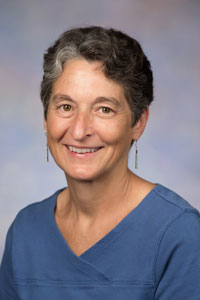 Ellen E. Martin (University of Florida)
Ellen E. Martin (University of Florida)
"Ellen has an impressive combination of a distinguished research program
in addition to an assiduous dedication to mentoring and leadership within
her department, university, and international scientific community."
—Andrea Dutton
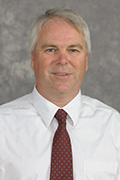 Michael C. Sukop (Florida International University).
Michael C. Sukop (Florida International University).
"Dr. Sukop's nomination is for his outstanding research publications and service
to the GSA Hydrogeology Division. His research includes using Lattice Boltzman
Modeling for investigating complex hydrogeological processes, such as multi-phase flow,
movement of droplets, and flow in karst. Dr. Sukop also investigates water management and coastal flooding in Florida." —Larry McKay
GSA’s newly elected Fellows will be recognized at the GSA 2018 Annual Meeting & Exposition Presidential Address & Awards Ceremony on 4 Nov. in Indianapolis, Indiana, USA
July 17, 2018 (Source: UF) - Medical Geography researchers from the University of Florida recently participated in a study that successfully predicted dengue fever outbreaks on the Caribbean island of Barbados, using climate data. This paper is part of a special issue of PLOS MEDICINE, focusing on the impacts of climate change on health, and is a result of an unprecedented collaborative project, funded by USAID to address climate driven health impacts in the Caribbean.
The study, led by Dr. Rachel Lowe from the London School of Hygiene and Tropical Medicine, tested whether dengue outbreaks in the Caribbean island of Barbados could be predicted using weather station data for temperature and a precipitation index (Standardized Precipitation Index- SPI) used to monitor drought and extreme rainfall. Using data from June 1999 to May 2016, researchers found that the statistical model was able to successfully predict months with dengue outbreaks versus non-outbreaks in most years. Dengue fever is spread by Aedes sp. mosquitos and infects over 350 million people each year, resulting in 25,000 deaths globally and costing households, governments, and businesses over $45 million annually. In recent decades, the disease has emerged as a major public health threat, and as many as 2 in 5 people globally are at risk of contracting dengue fever.
|
Image credit: Ms. Catherine Lippi. This study was conducted with epidemiological data collected in Barbados, an island located in the Caribbean (left). Population in Barbados (middle) and elevation on the island (right) are shown, as well as the location of the two meteorological stations that provided climate data for the study. |
UF Medical Geography professor Dr. Sadie Ryan and doctoral student Ms. Catherine Lippi collaborated on models that explored the delayed effect of climate indicators like extreme rainfall and drought on future outbreaks of dengue fever on the Caribbean island. “This study highlights the importance of keeping long term records of climate and health data so that we can learn about how a changing climate will impact our health and well-being in the future,” said Dr. Ryan.
The model found a sharp increase in disease transmission one to two months after extreme rainfall events, but a surprising result of the model was an increase in infections four to five months after a drought event. Lippi explained "During droughts, people store water in containers near their homes," she said, "which creates the perfect habitat for Aedes mosquitos." Senior author, Dr Stewart-Ibarra, from SUNY Upstate Medical University said she and others working on the project had heard from locals that this was a recurring trend but it wasn’t until they studied the data that they found it to be true. “Barbados is a water-scarce country. During periods of drought, people have to store water.”
The findings have been published in a paper titled Nonlinear and delayed impacts of climate on dengue risk in Barbados: A modelling study in PLOS Medicine.
The study was part of a collaboration between UF and the Caribbean Agency for Public Health, the Pan American Health Organization, the Caribbean Institute for Meteorology and Hydrology, as well as investigators from the London School of Hygiene and Tropical Medicine, SUNY Upstate Medical University, and the Escuela Superior Politecnica del Litoral of Ecuador.
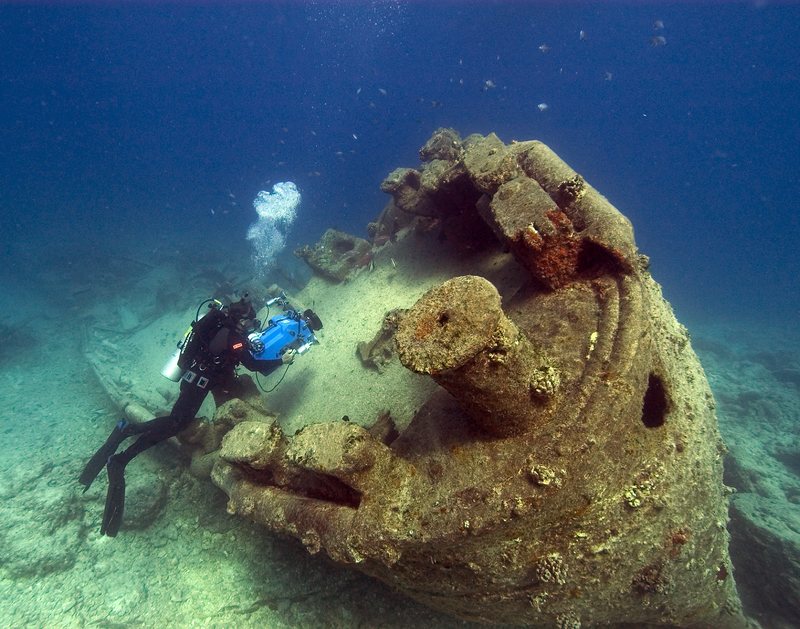 July 27, 2018 (Source: Atlas Obscura) - Climate change is coming for underwater archaeological sites. For years, archaeologists have been concerned with what climate change (e.g., sea level rise) might do to archeological sites. Climate-related threats facing submerged sites include sea level rise, storm surges, violent weather (e.g., hurricanes), changes in ocean temperature and acidity. "One way to get a handle on all of these dangers is to track them. That can be tricky, because archaeologists and rangers don't always stop by to regularly check in on watery wrecks as easily as they do terrestrial sites, says Sara Ayers-Rigsby, director of the southwest and southeast branches of the Florida Public Archaeology Network (FPAN), a project based out of the division of archaeology and anthropology at the University of West Florida and Florida Atlantic University.
July 27, 2018 (Source: Atlas Obscura) - Climate change is coming for underwater archaeological sites. For years, archaeologists have been concerned with what climate change (e.g., sea level rise) might do to archeological sites. Climate-related threats facing submerged sites include sea level rise, storm surges, violent weather (e.g., hurricanes), changes in ocean temperature and acidity. "One way to get a handle on all of these dangers is to track them. That can be tricky, because archaeologists and rangers don't always stop by to regularly check in on watery wrecks as easily as they do terrestrial sites, says Sara Ayers-Rigsby, director of the southwest and southeast branches of the Florida Public Archaeology Network (FPAN), a project based out of the division of archaeology and anthropology at the University of West Florida and Florida Atlantic University.
Read full article by Jessica Leigh Hester.
Photo: Wrecks stand to see a number of threats in a changing ocean. Here, NOAA diver John Brooks a ship off the coast of Hawaii. Robert Schwemmer, CINMS, NOAA/CC-by 2.0
August 15, 2018 (Source: UF Geography) - GAINESVILLE, FL – A University of Florida Medical Geography researcher recently participated in a study that found that current estimates of Zika virus transmission vastly over predict its possible range. Temperature is a major driver of vector-borne disease transmission, but current transmission models rely on untested assumptions about life history of Zika infected Aedes aegypti mosquitoes. Previous models of Zika transmission were based on similarities between Zika and dengue fever.
The study, led by Dr. Courtney Murdock from the University of Georgia, examined the influence of temperature on Zika transmission in lab-reared Aedes mosquitoes at eight different constant temperatures. Zika transmits optimally at a temperature similar to dengue, but the lowest possible transmission temperature of Zika is 5 degrees centigrade warmer than dengue. As global average temperatures increase under climate change the range of Zika will expand north and into longer transmission seasons, but some areas that are currently suitable for Zika transmission will no longer support transmission.
UF Medical Geography professor Dr. Sadie Ryan used the temperature relationships to make updated models and maps, which she compared with previous transmission models. “These maps show that the predicted area for year round risk of Zika transmission is over 6 million square kilometers smaller than previous models would predict,” said Ryan. “This shows that Zika is not dengue and we need to have specific transmission models for specific diseases.”
T he findings have been published in a paper titled Temperature drives Zika virus transmission: evidence from empirical and mathematical models in Proceedings of the Royal Society B.
he findings have been published in a paper titled Temperature drives Zika virus transmission: evidence from empirical and mathematical models in Proceedings of the Royal Society B.
The study was part of a collaboration between UF’s Dr. Sadie Ryan and Dr. Calistus Ngonghala, the CDC Southeastern Center of Excellence in Vector Borne Diseases, the University of Georgia, as well as investigators from Stanford University and Harvard Medical School.
Photo: Image courtesy of Proceedings of the Royal Society B. Months of transmission suitability in the Americas of dengue (left) and Zika (right).
August 2018 (Source: This email address is being protected from spambots. You need JavaScript enabled to view it., Florida A&M) - TALLAHASSEE, FL – Decision tools allow for the examination and prediction of impacts of altered climate on natural and managed ecosystems. They are useful in describing future risk, the marginality of systems, and guide actions to mitigate risk. Decades of studies have resulted in various tools, however, a few decision-making tools have been developed for planning and management of ecosystems due to future climate scenarios. Further, there remains a disconnect between the supply and demand of climate information and the need for tailoring the information for decision making purposes. This disconnect is exacerbated by the high volume of studies concerning climate change impacts to date and the availability and number of methods for scenario development. Further, the future is uncertain and unknown, therefore changes and variability in climate are not easily detected.
Given the high volume of studies and lines of evidence, and the availability of a number of methods for developing scenarios and the need to develop decision support tools; that developing a tool that combines scenario development and meta-analysis is novel, warranted and timely. Additionally, it would improve the linkages between climate-impacts research and planning, management, adaptation, and mitigation by providing quantitative information to stakeholders and managers.
Florida has many endemic plants, vertebrates, and insects that are only found in Florida and the tropics. Florida’s 2000 miles coastline contains diverse ecosystems and landscapes and habitat for many endangered species. In general, coastal estuaries and bays are of great ecological value and economic significance (produce about 50% of global ecosystem services that benefit humans). Florida’s agriculture yields 63% of the winter vegetables for the U.S. with revenues of $1.48 billion in 1995–1996. Florida is the fourth most populous state in the US and the third fastest growing state, with more than 17% net increase in population from 2000 to 2010. Florida’s biodiversity is threatened by these related stressors including: increasing, land-use change, increasing population and socioeconomic growth. These stressors and play a crucial role in facilitating adaptive change. The close proximity of coastal ecosystems, large human populations, and high productivity make ecosystems in Florida some of the most heavily utilized and threatened on the planet.
Researchers at FAMU have developed a decision support tool that could reduce the disconnect between the supply and demand for climate information in making decisions from climate change impacts, assessment, of natural and man-made ecosystems. The tool developed by this study has three major components: 1) perform meta-analysis --synthesize and combine recent relevant studies to arrive at conclusions about a body of research on temperature and precipitation changes, 2) develop climate scenario(s) [synthetic or incremental] from meta-analysis, Incremental scenario refers to a method of scenario development where a climatic variable is changed incrementally by arbitrary amounts and 3) development causal chain and loops. Although the developed decision tool is demonstrated by applying it to selected ecosystems and environments in Florida, USA, the tool can be used by multiple stakeholders in ecosystems and environments throughout the world.
 Meta-analyses result for Florida: 32 studies revealed precipitation changes ranged between +30% and -40%, while and temperature changes ranged from +6 °C and -3 °C for Florida. Meta-analysis represents a systematic approach to combining the results of relevant studies to arrive at conclusions about, how a body of research has been applied.
Meta-analyses result for Florida: 32 studies revealed precipitation changes ranged between +30% and -40%, while and temperature changes ranged from +6 °C and -3 °C for Florida. Meta-analysis represents a systematic approach to combining the results of relevant studies to arrive at conclusions about, how a body of research has been applied.
Incremental scenarios for Florida: Scenarios must be coherent, internally consistent, and represent plausible descriptions of possible future climate states. From meta-analysis, seven incremental scenarios, were developed at 10% increments in the precipitation change range (+30%, +20%, +10%, -10%, -20%, -30%, -40% precipitation changes) and nine scenarios with 1°C increments in the temperature change range (+6°C, +5°C, +4°C, +3°C, +2°C, +1°C, -1°C, -2°C, -3°C for temperature changes).
The causal chains/loops in Florida (Fig. below) were developed using Driver-Pressure-State-Impact-Response (DPSIR) framework for selected ecosystems and resources (e.g. agro-ecosystem, mangroves, water resources and sea turtles). The meta-analysis in these ecosystems, incremental scenarios as well as author expertise on the topic was used to identify the indicators used to represent the components of the DPSIR framework using chains/loops. The selected ecosystems and resources is impacted due to pressure exerted by the changes in temperature and pressure (incremental scenarios) and their response to them (e.g. mitigation and adaptation strategies) were shown in the causal chains/loops.

Anandhi, A., Sharma, A. and Sylvester, S., 2018. Can meta‐analysis be used as a decision making tool for developing scenarios and causal chains in eco‐hydrological systems?‐Case study in Florida. Ecohydrology, online.
 September 2018 (UCF, Tampa, FL) – Many cities across the globe are facing difficult challenges in managing their food, water, and energy systems. The challenges stem from the fact that the issues of food, water, and energy are often tightly connected with each other, not only locally but also globally. This is known as the Food-Water-Energy (FWE) nexus. An effective solution to a local water problem may cause new local problems with food or energy, or cause new water problems at the global level. On a local scale, it is difficult to anticipate whether solutions to one issue in the nexus are sustainable across food, water, and energy systems, both at the local and the global scale. Innovative solutions that encompass the nexus are particularly important to enable cities to better manage their food, water and energy systems and understand the benefits and tradeoffs for different solutions.
September 2018 (UCF, Tampa, FL) – Many cities across the globe are facing difficult challenges in managing their food, water, and energy systems. The challenges stem from the fact that the issues of food, water, and energy are often tightly connected with each other, not only locally but also globally. This is known as the Food-Water-Energy (FWE) nexus. An effective solution to a local water problem may cause new local problems with food or energy, or cause new water problems at the global level. On a local scale, it is difficult to anticipate whether solutions to one issue in the nexus are sustainable across food, water, and energy systems, both at the local and the global scale. Innovative solutions that encompass the nexus are particularly important to enable cities to better manage their food, water and energy systems and understand the benefits and tradeoffs for different solutions.
Ni-Bin Chang, PhD, Professor in the Department of Civil, Environmental Engineering, and Construction Engineering at the University of Central Florida, has been awarded a National Science Foundation (NSF) research grant entitled: “(ENLARGE) Enabling large-scale adaptive integration of technology hubs to enhance community resilience through decentralized urban food-water-energy nexus decision support.” The project aims to generate actionable information by analyzing the distributed production and storage of materials and energy flows into, out of, and within a community/city given their consumption patterns and supply chains associated with various FWE nexuses. This project will develop a multi-scale modeling framework to address the inter-relationship between multiple stressors affecting the food-water-energy nexus in 3 urban environments, Amsterdam, Miami, and Marshall. The models will investigate the impacts of increasing metropolitan populations, rapid land use change, shifting social, economic and governance norms, escalating climate variability, and changing ecosystem services within each of the investigated FWE nexus to elucidate the resultant water, carbon, and ecological footprint for each location. Read more..
September 2018 (USF, St. Petersburg, FL) - A combination of record-breaking rainfall and inadequate floodplain management led to historic flooding of many coastal cities around the US Gulf of Mexico in 2017. Flooding of developed and built coastal zones is occurring more frequently every year. Many flat, low-lying coastal communities have grown to be large, and residents face high risk of property and financial risk as a changing climate brings higher average sea levels and more frequent extreme storm events every year. Mitigating these risks requires information on coastal topography, vegetation types, and development patterns around coastal cities, for updated flood maps.
Frank Muller-Karger, PhD, Professor at the College of Marine Science of the University of South Florida, has been awarded a National Science Foundation grant ($1,000,000) to establish a Big Data Regional Innovation Hub for a three-year study of these problems in collaboration with Texas A&M University and Google Earth Engine. Dr. Muller-Karger leads a team of researchers that includes Drs. Matt McCarthy, Tim Dixon, graduate students and postdoctoral researchers at USF, James Gibeaut at Texas A&M Corpus Christi, Paul Morin at the University of Minnesota, and Lea Shanley from the South Big Data Hub to update topographic and land cover maps for the entire US Gulf of Mexico coastal plain. Using high-resolution satellite imagery, LiDAR data, and supercomputing resources, the team will update land elevation data and improve land cover maps with a spatial resolution of up to 200 times greater than existing maps at this scale for areas within 50 km of the coast.
Prototype 3-dimensional models will also be developed for the cities of Tampa, St. Petersburg, and Corpus Christi using structure-from-motion (SfM) techniques. Combined with the elevation and land maps, these models will help coastal cities develop plans for sustainable growth while mitigating losses due to flooding, which is forecast to increase with rising sea levels. The maps will be freely available to researchers, managers, and to the general public.
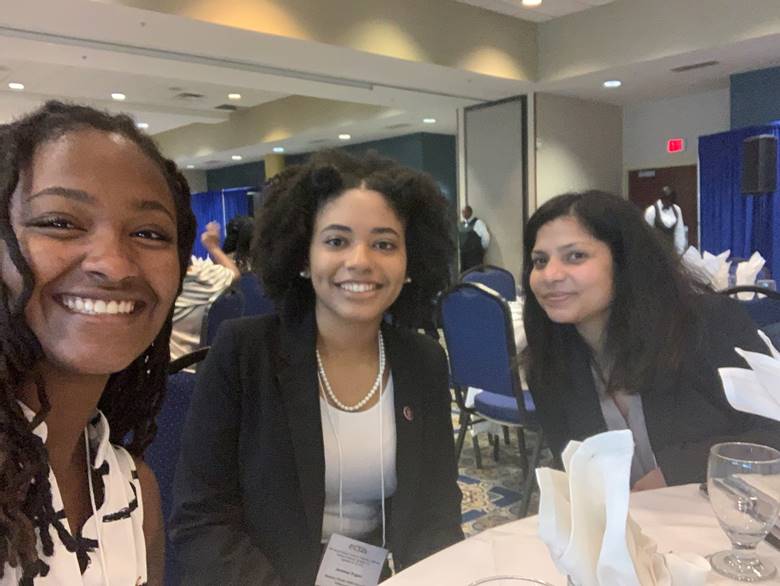 Ms. Mikela Pryor, Ms. Janessa Pagan, Ms. Anjali Sharma at the National Technical Association conference in September at Hampton University, VA. Ms. Mikela Pryor, Ms. Janessa Pagan, Ms. Anjali Sharma at the National Technical Association conference in September at Hampton University, VA.
|
(FAMU, Tallahassee, FL) – Summer and Fall 2018 has been productive for the students and faculty in the Biological Systems Engineering program at the College of Agriculture and Food Sciences (CAFS). Ms. Mikela Pryor and Ms. Lesley-Ann Jackson won the 1st place and honorary mention in the poster competition held by sustainability institute at FAMU. Ms. Mikela Pryor, Ms. Janessa Pagan, Ms. Anjali Sharma won the National Technical Association Scholarship to present their work at the conference on September 26-28 at Hampton University, VA, USA 2018. These students were funded by Dr. Aavudai Anandhi's USDA and NSF grants to develop innovative teaching methods to teach abstract, complex concepts in natural resource engineering as well as to train multi-disciplinary graduate students in sustainable Food-Water-Energy nexus. The encouragement and support from students, colleagues, administrators and teaching and learning center is acknowledged.
At the Florida Section American Society of Agricultural and Biological Engineering (ASABE) Conference 2018 was held at the Hutchinson Shores Resort, June 13-16 faculty, undergraduate and graduate students were very active. Dr. Aavudai Anandhi Swamy was one of three general session panelists. She spoke about “Environment change, it’s assessment, adaptation and mitigation-an opportunity to utilize the benefits and reduce the harmful effects of change. Ms. Anjali Sharma won 2nd place in the graduate student presentation competition. Her mentor, Dr. Anandhi, was presented with “The Teacher of the Year Award”. Students of the FAMU section of ASABE club presented their work at the conference meeting.
 Dr. Anandhi received FAMU’s emerging researcher award 2018. Dr. Anandhi also received the Educational Aids Blue Ribbon Awards at the American Society of Agricultural and Biological Engineering (ASABE)’s annual international meeting from July 29 – August 1, 2018 at Detroit, Michigan. The blue ribbon award recognizes excellence in informational materials which contribute to the understanding of agricultural and biological engineering subjects. Her innovative teaching method of using Leaf analogy to teach watershed concept won her the blue ribbon award in short publication category.
Dr. Anandhi received FAMU’s emerging researcher award 2018. Dr. Anandhi also received the Educational Aids Blue Ribbon Awards at the American Society of Agricultural and Biological Engineering (ASABE)’s annual international meeting from July 29 – August 1, 2018 at Detroit, Michigan. The blue ribbon award recognizes excellence in informational materials which contribute to the understanding of agricultural and biological engineering subjects. Her innovative teaching method of using Leaf analogy to teach watershed concept won her the blue ribbon award in short publication category.
Undergraduate and graduate students, in Dr. Anandhi’s group developed a 3-in-1 tool for climate change assessments. This tool could help decision makers plan the best course of action in an altering way. Their evidence-based approach combines three climate research methods to tailor action plans to the needs of a given area: whether that’s an entire country or state, or a single community. This work was published in Ecohydrology journal.
Pictured at left: Dr. Satyanarayan Dev was awarded the Young Engineer Award by the Canadian Society of Bioengineering during the Annual General Meeting on July 25, 2018 at the University of Guelph, Guelph, ON, Canada.
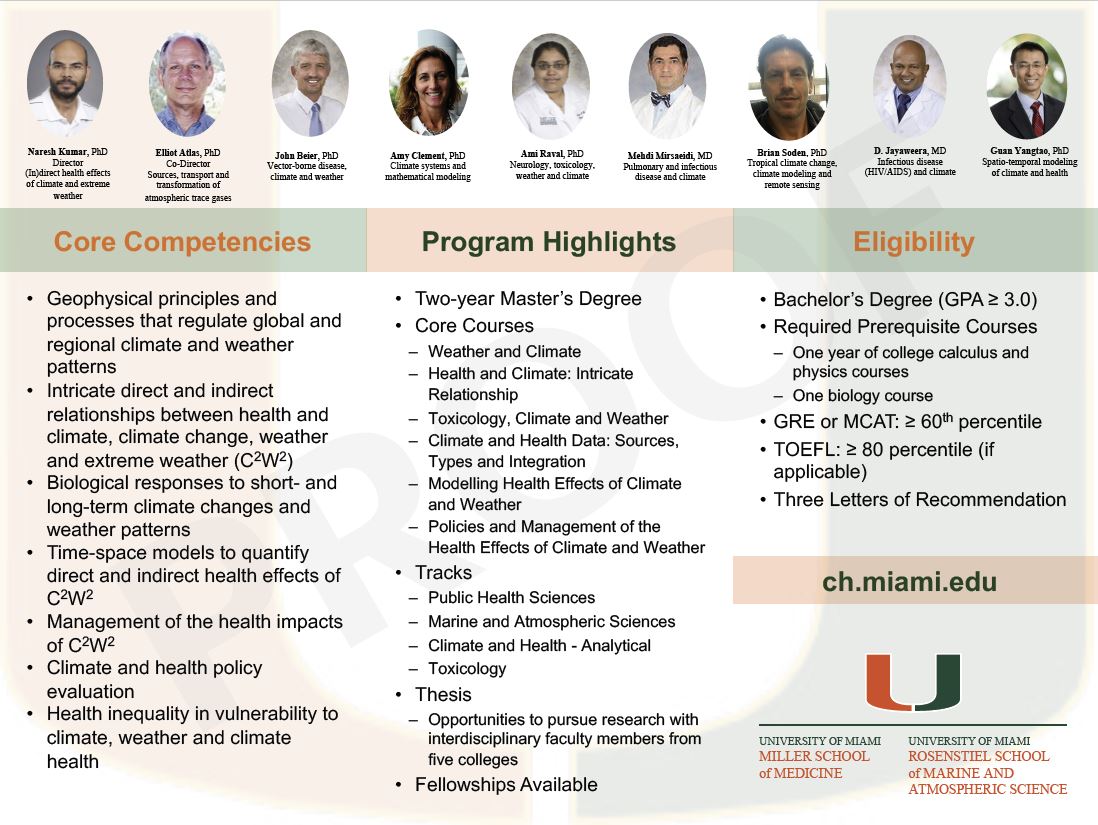 February 2019 (Source: UM) - The University of Miami's Miller School of Medicine and Rosentiel School of Marine and Atmospheric Research (RSMAS) will launch a Master of Science in Climate and Health (U-MSCH) graduate program to begin in Fall 2019. The program will train future generations of professionals, research analysts, planners, decision-makers and leaders to address the intricate relationship between human health and climate, climate change and weather patterns, and weather anomalies, and quantify this relationship at multiple scales ranging from gene expression to individual susceptibility, community response, and the regional morbidity and mortality burden.
February 2019 (Source: UM) - The University of Miami's Miller School of Medicine and Rosentiel School of Marine and Atmospheric Research (RSMAS) will launch a Master of Science in Climate and Health (U-MSCH) graduate program to begin in Fall 2019. The program will train future generations of professionals, research analysts, planners, decision-makers and leaders to address the intricate relationship between human health and climate, climate change and weather patterns, and weather anomalies, and quantify this relationship at multiple scales ranging from gene expression to individual susceptibility, community response, and the regional morbidity and mortality burden.
The two-year program will offer four tracks: Public Health Sciences, Marine and Atmospheric Sciences, Climate and Health - Analytical, and Toxicology. Fellowships are available. Click here for more information
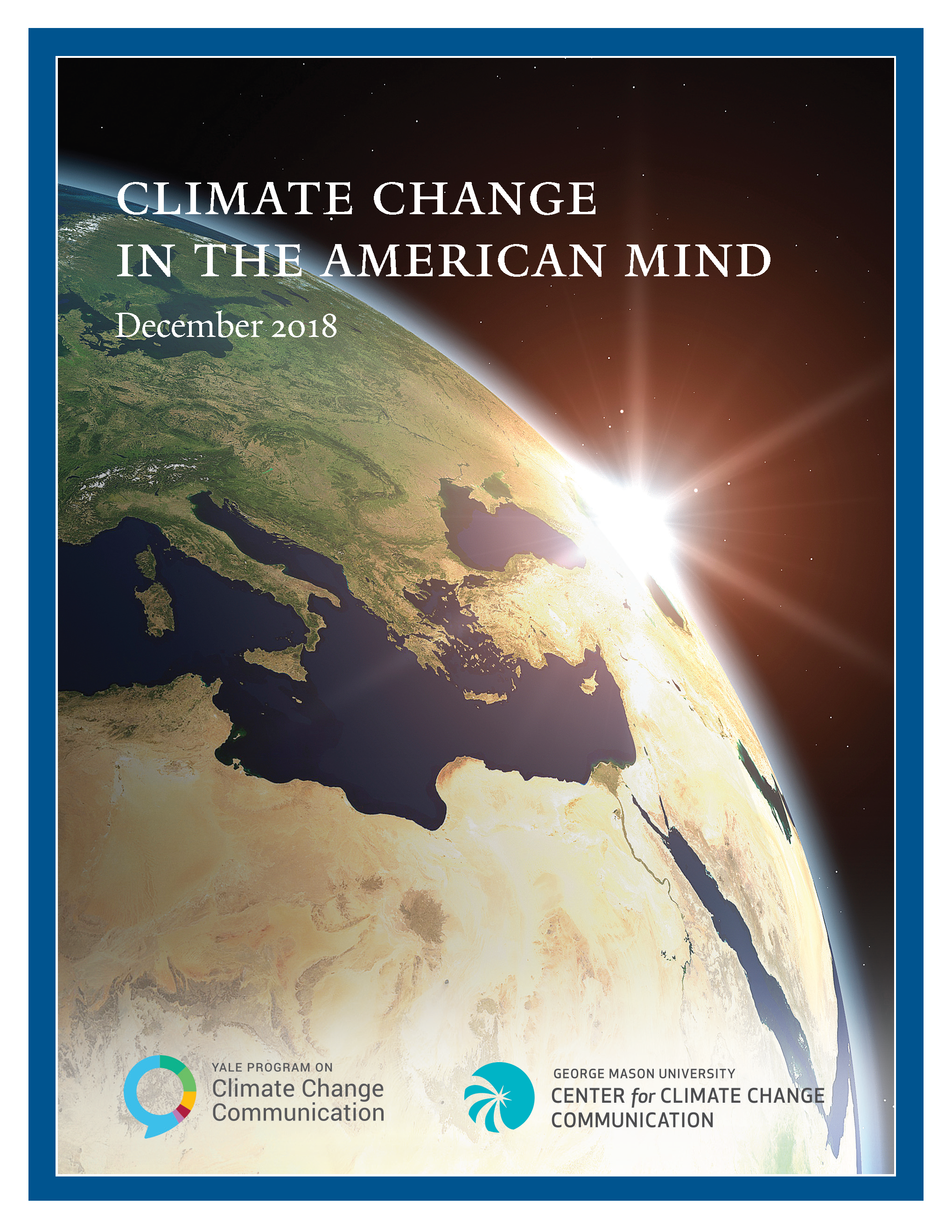 March 2019 - The latest national survey by the Yale Program on Climate Change Communication and the George Mason University Center for Climate Change Communication finds that a large majority of Americans think global warming is happening, outnumbering those who don't by more than five to one. Americans are also growing more certain that global warming is happening and more aware that it is caused by human activities. Certainty has increased 14 percentage points since March 2015, with 51% of the public now "extremely" or "very sure" that global warming is happening. Sixty-two percent of the public now understands that global warming is caused mostly by human activities, an increase of 10 points over that same time period.This report analyzes American's increasing awareness and concern about global warming and its associated risks. Read the report.
March 2019 - The latest national survey by the Yale Program on Climate Change Communication and the George Mason University Center for Climate Change Communication finds that a large majority of Americans think global warming is happening, outnumbering those who don't by more than five to one. Americans are also growing more certain that global warming is happening and more aware that it is caused by human activities. Certainty has increased 14 percentage points since March 2015, with 51% of the public now "extremely" or "very sure" that global warming is happening. Sixty-two percent of the public now understands that global warming is caused mostly by human activities, an increase of 10 points over that same time period.This report analyzes American's increasing awareness and concern about global warming and its associated risks. Read the report.
 March 2019 - On March 1, the City of Miami broke ground for the first Miami Forever Bond Project - the Fairview Flood Mitigation. The project has two phases and is estimated to be completed by early 2020. The first phase is meant to protect against most of the weather events that the city is experiencing right now such as King Tide flooding and dramatic rain events. The second phase is a pump station that will pump between 20,000 and 30,000 gallons a minute.
March 2019 - On March 1, the City of Miami broke ground for the first Miami Forever Bond Project - the Fairview Flood Mitigation. The project has two phases and is estimated to be completed by early 2020. The first phase is meant to protect against most of the weather events that the city is experiencing right now such as King Tide flooding and dramatic rain events. The second phase is a pump station that will pump between 20,000 and 30,000 gallons a minute.
The City of Miami plans to use the Fairview Flood Mitigation project as a means to understand the effectiveness of water outfall back-flow valves and how to best address storm surge and sea-level rise. Watch the Fairview Flood Mitigation Project Groundbreaking.
April 2019 - A recently published book by Diana Mitsova and Ann-Margaret Esnard, Geospatial Applications for Climate Adaptation Planning, presents an overview of the range of strategies, tools, and techniques that must be used to assess myriad overlapping vulnerabilities and to formulate appropriate climate-relevant solutions at multiple scales and in varying contexts. Each chapter is grounded in the literature and presents case studies designed by the authors, as well as many examples from a diverse international group of scholars and entities in the public and private sectors. Areas covered include: Climate Change and Climate Adaptation Planning: Context and Concepts Geospatial Technologies: Fundamentals and Terminology GIS and Climate Vulnerability Assessments Technical Approaches to Formulating Mitigation and Adaptation Strategies Geospatial Applications for Climate Adaptation Planning is aimed at advanced students, researchers, and entities in the public and private sectors. It also provides supplementary reading for courses in planning, public administration, policy studies, and disaster management.
 May 2019 - Michael Volk, Research Assistant Professor in the Department of Landscape Architecture, and Dr. Gail Hansen, Associate Professor in the Department of Environmental Horticulture at the University of Florida, have been awarded a California Landscape Architectural Student Scholarship (CLASS) Fund Research Award from the Council of Educators in Landscape Architecture (CELA).
May 2019 - Michael Volk, Research Assistant Professor in the Department of Landscape Architecture, and Dr. Gail Hansen, Associate Professor in the Department of Environmental Horticulture at the University of Florida, have been awarded a California Landscape Architectural Student Scholarship (CLASS) Fund Research Award from the Council of Educators in Landscape Architecture (CELA).
This one-year project, entitled Future Landscape Professionals of the Anthropocene, will collect data on college curricula, teaching methods, and attitudes of students and teachers to identify and evaluate best practices for integrating climate change and climate-wise design strategies into landscape architecture and horticulture programs.The research team includes Dr. Belinda B. Nettles, Research Affiliate with the University of Florida's Center for Landscape Conservation Planning, and Isabella Guttuso, a Master of Landscape Architecture student. Project results will be posted on the Center for Landscape Conservation Planning's website Landscape Change. This website is part of the Center's broad initiative to advance climate-wise design and information sharing among landscape professionals.
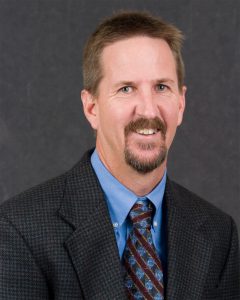 May 2019 (Source: UF/IFAS News) Governor Ron DeSantis announced in April that University of Florida scientist Tom Frazer will be the state's first Chief Science Officer. Frazer will lead efforts to address some of Florida's most critical environmental challenges, including red tide and harmful algal blooms, which have impacted millions of Floridians, said Jack Payne, Working with the governor's staff, state agencies and a state-wide task force, Frazer will work to find science-based solutions to environmental issues important to Florida residents, according to a statement from the governor's office. "It's a great honor to be asked to serve in this role, and I'm ready to start working with state leaders and our best researchers to protect our water and our environment," Frazer said. This won't be the first time Frazer has headed a diverse team to tackle complex problems. As director of the UF/IFAS School of Natural Resources and Environment, Frazer led faculty members from 56 departments across 12 colleges, who worked on issues ranging from transitioning to renewable energy systems, preventing pollution, protecting biodiversity and climate change. Frazer will retain his faculty appointment at UF while serving as Chief Science Officer. Read the article.
May 2019 (Source: UF/IFAS News) Governor Ron DeSantis announced in April that University of Florida scientist Tom Frazer will be the state's first Chief Science Officer. Frazer will lead efforts to address some of Florida's most critical environmental challenges, including red tide and harmful algal blooms, which have impacted millions of Floridians, said Jack Payne, Working with the governor's staff, state agencies and a state-wide task force, Frazer will work to find science-based solutions to environmental issues important to Florida residents, according to a statement from the governor's office. "It's a great honor to be asked to serve in this role, and I'm ready to start working with state leaders and our best researchers to protect our water and our environment," Frazer said. This won't be the first time Frazer has headed a diverse team to tackle complex problems. As director of the UF/IFAS School of Natural Resources and Environment, Frazer led faculty members from 56 departments across 12 colleges, who worked on issues ranging from transitioning to renewable energy systems, preventing pollution, protecting biodiversity and climate change. Frazer will retain his faculty appointment at UF while serving as Chief Science Officer. Read the article.
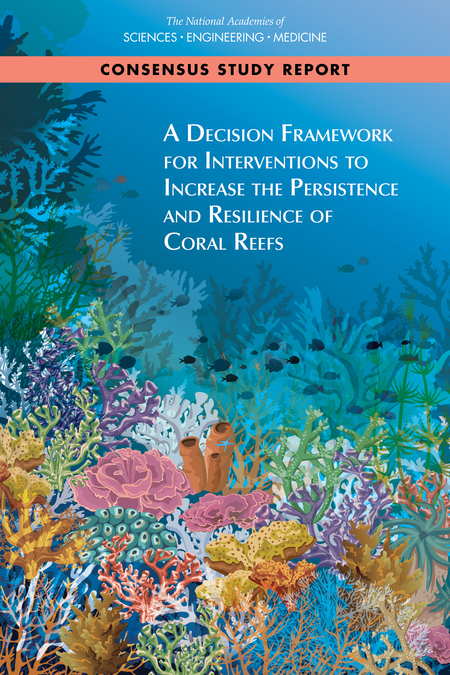 June 2019 - Coral reef managers are faced with a crisis: deteriorating environmental conditions are reducing the health and functioning of coral reef ecosystems worldwide. These threats compound the persistent local stresses coral reefs have experienced for decades from pollution, overfishing, and habitat destruction. Established approaches for managing coral reefs are neither sufficient, nor designed, to preserve corals in a changing climate. A growing body of research on “coral interventions” aims to increase the ability of coral reefs to persist in rapidly degrading environmental conditions. Those interventions include activities that affect the genetics, reproduction, physiology, ecology, or local environment of corals or coral populations. A first report, released by the National Academy of Sciences in November 2018, reviewed the current state of the science for 23 novel interventions. This report provides a decision framework to help managers assess and implement interventions that are suitable for their region and goals. Get the report.
June 2019 - Coral reef managers are faced with a crisis: deteriorating environmental conditions are reducing the health and functioning of coral reef ecosystems worldwide. These threats compound the persistent local stresses coral reefs have experienced for decades from pollution, overfishing, and habitat destruction. Established approaches for managing coral reefs are neither sufficient, nor designed, to preserve corals in a changing climate. A growing body of research on “coral interventions” aims to increase the ability of coral reefs to persist in rapidly degrading environmental conditions. Those interventions include activities that affect the genetics, reproduction, physiology, ecology, or local environment of corals or coral populations. A first report, released by the National Academy of Sciences in November 2018, reviewed the current state of the science for 23 novel interventions. This report provides a decision framework to help managers assess and implement interventions that are suitable for their region and goals. Get the report.
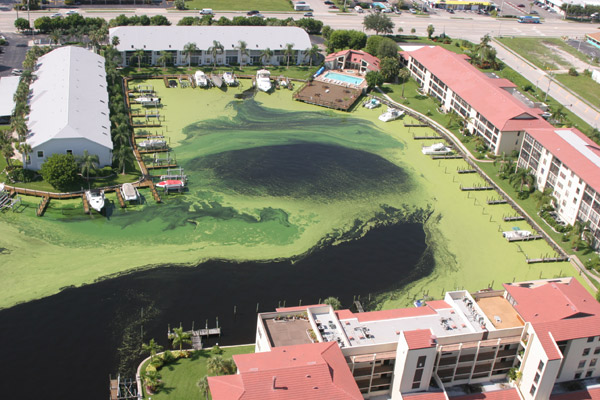 June 2019 - The Florida Department of Environmental Protection has launched a new interactive algal bloom dashboard. This dashboard is a visual enhancement to the state's existing sampling slate. This data has been publicly available on DEP's website, but previously did not allow the public to easily see where algal blooms were occurring in Florida, in real time. The algal bloom dashboard features real-time updates of sample locations for up to 90 days and all available details related to those samples, such as photos and toxin information. Users can search by specific address, zip code, city or place. The tool includes quick links to other resources such as public health information.
June 2019 - The Florida Department of Environmental Protection has launched a new interactive algal bloom dashboard. This dashboard is a visual enhancement to the state's existing sampling slate. This data has been publicly available on DEP's website, but previously did not allow the public to easily see where algal blooms were occurring in Florida, in real time. The algal bloom dashboard features real-time updates of sample locations for up to 90 days and all available details related to those samples, such as photos and toxin information. Users can search by specific address, zip code, city or place. The tool includes quick links to other resources such as public health information.
June 16, 2019 (Source: Federal Reserve Bank of San Francisco) -- Climate change is already causing disruption to regional economic activity. Low-to-moderate income populations are highly vulnerable to these impacts, in part, because they often have fewer resources to adapt. The stability and prosperity of local economies in the face of climate change depends on how well the public, private, and civic sectors can come together to respond to the shocks and stresses of climate change. Collaborative efforts to fund climate adaptation not only reduce the burden on highly vulnerable populations, but they also offer the opportunity for co-benefits within a broader portfolio of community development ambitions.
This report introduces the field of climate adaptation finance and explains its connection to the Community Reinvestment Act (CRA) within the context of the disaster provisions guiding pre- and post-disaster investments. In a demonstration of need, the report provides evidence of the spatial concentration of disaster declarations in areas with CRA-eligible populations. It highlights existing innovative and hypothetical investments within a broader context for stimulating greater pre-disaster planning and investment.
Community development practitioners, investors and policymakers will find this report useful for sparking new ideas about how to develop partnerships and funding streams for CRA-eligible activities—in both eligible communities and areas within a federal disaster declaration—that will reduce the vulnerability and increase the adaptive capacity of communities to the impacts of climate change.
Article Citation
Keenan, Jesse M, and Elizabeth Mattiuzzi. 2019. “Climate Adaptation Investment and the Community Reinvestment Act,” Federal Reserve Bank of San Francisco Community Development Research Brief 2019-5. Available at https://doi.org/10.24148/cdrb2019-05
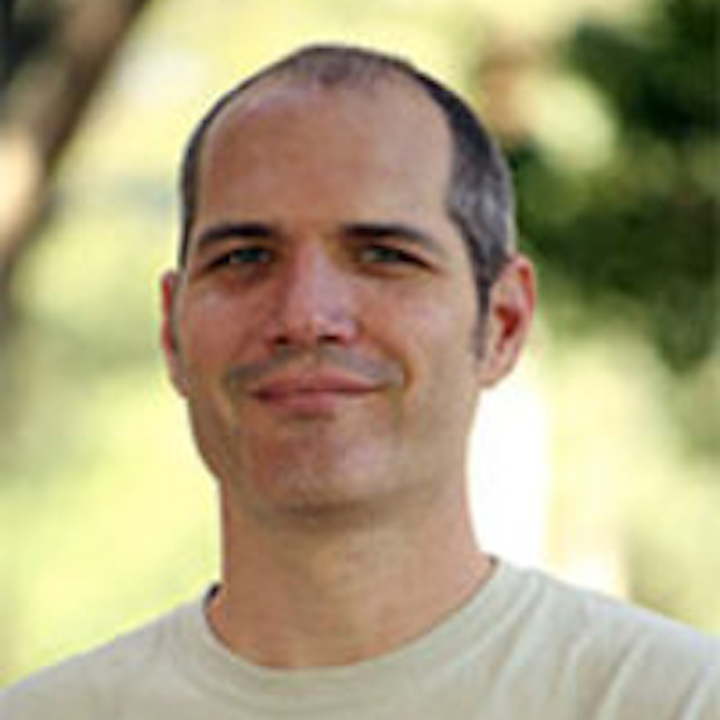 DELAND, FLA, JUNE 26, 2019 -- Stetson University has named Jason Evans, Ph.D., as the interim executive director of the Institute for Water and Environmental Resilience (IWER). His role begins on Aug. 15. Evans will fill the position while Stetson searches for a permanent replacement for Clay Henderson, J.D., who is retiring. Evans is an associate professor of environmental science and studies at Stetson as well as faculty director of IWER. Henderson’s Stetson accomplishments include developing and organizing IWER and its staff, including the advisory and faculty steering committees, affiliate faculty and endowment; creating and administering the Sustainable Farming Fund to incentivize sustainable agriculture in the Suwannee River basin; and planning and conducting fundraising associated with the Sandra Stetson Aquatic Center. Read the article.
DELAND, FLA, JUNE 26, 2019 -- Stetson University has named Jason Evans, Ph.D., as the interim executive director of the Institute for Water and Environmental Resilience (IWER). His role begins on Aug. 15. Evans will fill the position while Stetson searches for a permanent replacement for Clay Henderson, J.D., who is retiring. Evans is an associate professor of environmental science and studies at Stetson as well as faculty director of IWER. Henderson’s Stetson accomplishments include developing and organizing IWER and its staff, including the advisory and faculty steering committees, affiliate faculty and endowment; creating and administering the Sustainable Farming Fund to incentivize sustainable agriculture in the Suwannee River basin; and planning and conducting fundraising associated with the Sandra Stetson Aquatic Center. Read the article.
July 2, 2019 (By Kirsty Scandrett, University of Florida) - New research, published in Journal of Applied Ecology maps the peak temperatures for the establishment of citrus greening disease.
|
|
Orange juice is a staple on many breakfast tables, but the future availability of citrus products is threatened by the global spread of Huanglongbing (HLB), also known as citrus greening disease. The bacterium responsible for causing citrus greening prevents the formation of commercially viable fruit and is transmitted by an insect called the Asian citrus psyllid. Both the pathogen and the insect vector have been spreading in recent years, devastating regions famous for high citrus production and threatening the future of the citrus industry. As citrus greening becomes an increasing threat to growers worldwide, the future of the industry may depend on identifying locations that do not have a high risk of production collapse.

The Coastal Planning Program newsletter contains valuable science, policy, planning, risk and insurance, and economics resources for anyone working on coastal resiliency and planning in Florida and beyond. To check out the Sea Grant Coastal Planning page go to http://www.flseagrant.org/climate-change/coastalplanning/. Or, Please send an email to Thomas Ruppert requesting to be added to the newsletter mailing list.
The proposed Florida Climate Assessment will:
- Produce a strategic tool with standards, data, analyses, and thresholds for use in planning, decision-making, setting research agendas, and use in public policy and legislation
- Ensure resiliency decisions are informed by the best available science through an iterative, stakeholder driven process that is easily updated and user-focused
- Use the best science in a manner that is responsive, supportive, and critical focusing on systems and not separate sectors
- Improve relationships between knowledge producers and users and yield better decisions and outcomes to build capacity and overcome barriers
We want to know your thoughts on the proposed Florida Climate Assessment and its potential value to your work and to the state of Florida. This email address is being protected from spambots. You need JavaScript enabled to view it. and please include your name, contact information, affiliation, and position.
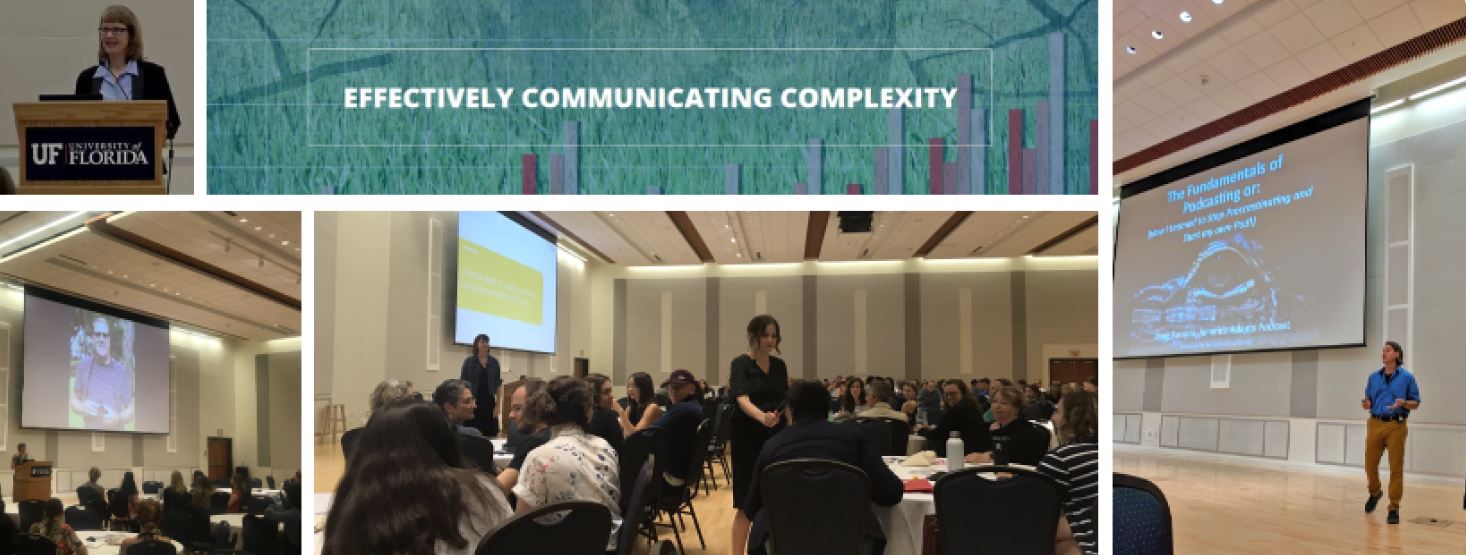
- Climate Communications Summit: https://mediasite.video.ufl.edu/Mediasite/Play/8aa5aa261eb349c39b0a01026161c1f51d
- Doug Parson's Podcast session is available here: https://mediasite.video.ufl.edu/Mediasite/Play/76ed71e2268840b9b810722d83b4c4af1d
 In March, the Florida Public Service Commission unanimously approved the Florida Power & Light Co. (FPL) SolarTogether program which will ensure the development of 1,490 MW of solar over the next two years making it the largest community solar program in the U.S. The program will help to propel the Sunshine State into a leadership position on solar development and reduce dependence on fossil fuels that contribute to climate change. This voluntary solar program puts participants in full control of their level of commitment. Customers can offset up to 100% of their electricity use with emissions-free solar. Read the article here.
In March, the Florida Public Service Commission unanimously approved the Florida Power & Light Co. (FPL) SolarTogether program which will ensure the development of 1,490 MW of solar over the next two years making it the largest community solar program in the U.S. The program will help to propel the Sunshine State into a leadership position on solar development and reduce dependence on fossil fuels that contribute to climate change. This voluntary solar program puts participants in full control of their level of commitment. Customers can offset up to 100% of their electricity use with emissions-free solar. Read the article here.
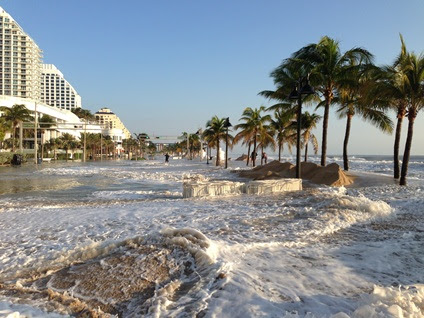 (Source: Science World) Half of the world's beaches could disappear by the end of the century due to coastal erosion, according to a new study led by the European Commission Joint Research Centre (JRC). Erosion is a major problem facing sandy beaches that will worsen with the rising sea levels brought about by climate change. According to the study, published today in Nature Climate Change, effective climate action could prevent 40% of that erosion. Sandy beaches cover more than 30% of the world's coastlines. They are popular recreational spots for people and they provide important habitats for wildlife. They also serve as natural buffer zones that protect the coastline and backshore coastal ecosystems from waves, surges and marine flooding. Their role as shock absorbers will become more important with the rising sea levels and more intense storms expected with climate change. Read article here.
(Source: Science World) Half of the world's beaches could disappear by the end of the century due to coastal erosion, according to a new study led by the European Commission Joint Research Centre (JRC). Erosion is a major problem facing sandy beaches that will worsen with the rising sea levels brought about by climate change. According to the study, published today in Nature Climate Change, effective climate action could prevent 40% of that erosion. Sandy beaches cover more than 30% of the world's coastlines. They are popular recreational spots for people and they provide important habitats for wildlife. They also serve as natural buffer zones that protect the coastline and backshore coastal ecosystems from waves, surges and marine flooding. Their role as shock absorbers will become more important with the rising sea levels and more intense storms expected with climate change. Read article here.
 (Source Climate Outreach) Having conversations about climate change in our daily lives plays a huge role in creating social change. People take cues about what's important from what family, friends, colleagues and neighbors are talking about. That's why Climate Outreach has produced an evidence-based, practical guide to help make those conversations easier and more meaningful - and to come out of them feeling inspired and connected. Talking Climate Handbook is the result of a collaboration with Climate-KIC. It is based in part on a citizen science project with over 550 individuals from over 50 countries that took place last summer. Download the handbook here.
(Source Climate Outreach) Having conversations about climate change in our daily lives plays a huge role in creating social change. People take cues about what's important from what family, friends, colleagues and neighbors are talking about. That's why Climate Outreach has produced an evidence-based, practical guide to help make those conversations easier and more meaningful - and to come out of them feeling inspired and connected. Talking Climate Handbook is the result of a collaboration with Climate-KIC. It is based in part on a citizen science project with over 550 individuals from over 50 countries that took place last summer. Download the handbook here.
Floridians believe climate change is real and are concerned about its impact on future generations in the state, according to the second Florida Climate Resilience Survey, conducted by the Florida Atlantic University Center for Environmental Studies (CES) in FAU's Charles E. Schmidt College of Science, and the Business and Economics Polling Initiative (BEPI) in FAU's College of Business. This quarterly statewide survey shows that 86 percent of Floridians believe climate change is happening, including 81 percent of Republicans, 91 percent of Democrats and 87 percent of Independents.
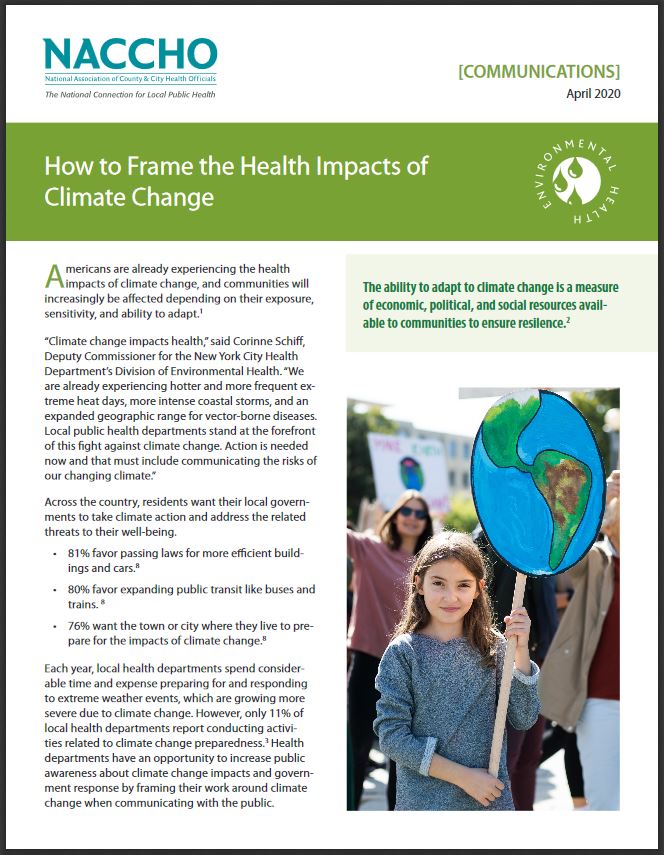 Each year, local health departments spend considerable time and expense preparing for and responding to extreme weather events, which are growing more severe due to climate change. However, only 11% of local health departments report conducting activities related to climate change preparedness. The National Association of County and City Health Officials (NACCHO) has published a new information sheet - How to Frame the Health Impacts of Climate Change - to help health departments frame their work around climate change when communicating with the public.
Each year, local health departments spend considerable time and expense preparing for and responding to extreme weather events, which are growing more severe due to climate change. However, only 11% of local health departments report conducting activities related to climate change preparedness. The National Association of County and City Health Officials (NACCHO) has published a new information sheet - How to Frame the Health Impacts of Climate Change - to help health departments frame their work around climate change when communicating with the public.
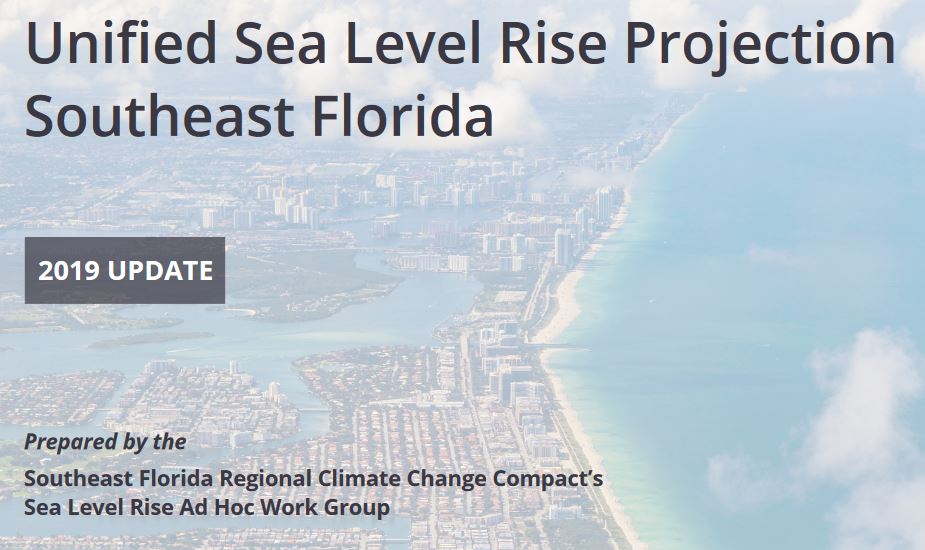 The Southeast Florida Regional Climate Change Compact has published a guidance report to accompany the third update of the Regionally Unified Sea Level Rise Projection for Southeast Florida. The projection was released in December 2019 at the Compact's 11th Annual Climate Leadership Summit. The updated projection and accompanying guidance report are currently in the process of final review and acceptance by all four of the Compact counties.
The Southeast Florida Regional Climate Change Compact has published a guidance report to accompany the third update of the Regionally Unified Sea Level Rise Projection for Southeast Florida. The projection was released in December 2019 at the Compact's 11th Annual Climate Leadership Summit. The updated projection and accompanying guidance report are currently in the process of final review and acceptance by all four of the Compact counties.
Regionally Unified Sea Level Rise Projection and this guidance document were developed by an ad hoc Sea Level Rise Work Group of experts from academia and federal agencies, and supported by individuals from local government and Compact staff. The guidance report is intended to assist decision-makers at both the local and regional levels in Southeast Florida to plan for and make decisions about sea level rise and associated vulnerabilities based on best-available science.
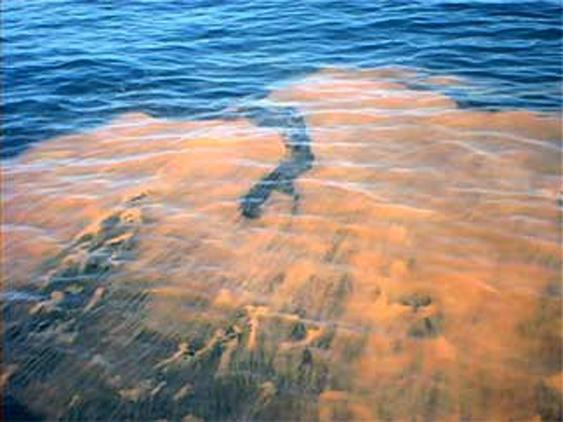 The Gulf of Mexico Coastal Ocean Observing System (GCOOS) and NOAA's National Centers for Coastal Ocean Science (NCCOS) are funding two new studies designed to uncover the full costs of harmful algal blooms (HABs) across numerous sectors - from tourism and seafood to industries where impacts are less visible, such as healthcare and construction. As a state that relies heavily on these sectors, Florida is especially vulnerable to the socioeconomic damages of toxic blooms. This was apparent during the prolonged red tide that began in 2017 and lasted through early 2019, causing the state's governor to declare a state of emergency.
The Gulf of Mexico Coastal Ocean Observing System (GCOOS) and NOAA's National Centers for Coastal Ocean Science (NCCOS) are funding two new studies designed to uncover the full costs of harmful algal blooms (HABs) across numerous sectors - from tourism and seafood to industries where impacts are less visible, such as healthcare and construction. As a state that relies heavily on these sectors, Florida is especially vulnerable to the socioeconomic damages of toxic blooms. This was apparent during the prolonged red tide that began in 2017 and lasted through early 2019, causing the state's governor to declare a state of emergency.
The funded studies will evaluate the sociological and economic impacts of Florida's 2017-2019 red tide event and develop a framework to inform future assessments of other HAB events with the goal of mitigating economic impacts on communities.
"From Bloom to Bust: Estimating Economic Losses and Impacts of Florida Red Tide (Karenia brevis)" will be conducted by Drs. Sergio Alvarez from the University of Central Florida and Dr. Heather O'Leary from the University of South Florida. This two-year project will examine the economic impacts of K. brevis events across 80 different sectors, based on varied bloom occurrence and intensity. Understanding the true costs of HABs is key to developing effective response and adaptation strategies that meet the needs of impacted communities in Florida and around the country.
"Assessment of the short- and long-term socioeconomic impacts of Florida's 2017-2019 Red Tide event" will be conducted by Drs. Christa Court, Xiang Bi, Jin Won Kim, Angie Lindsey, Stephen Morgan, Andrew Ropicki and Ricky Telg from the University of Florida and David Yoskowitz from the Harte Research Institute, Texas A&M University Corpus Christi. This two-year project will comprehensively quantify and qualify the short- and long-term socioeconomic impacts of the 2017-2019 Karenia brevis event in Florida and develop a transferable framework to help inform national-scale efforts focused on quantifying as well as measuring community vulnerability and resiliency.
Florida's Executive Office of the Governor has released the Chief Resilience Officer (CRO) 2019 Annual Report prepared by Julia Nesheiwat, the state's former CRO. The 36-page report discusses the Officer's goals and proposes "what can be done to start effective resilience planning and action." Download a copy of the report here.
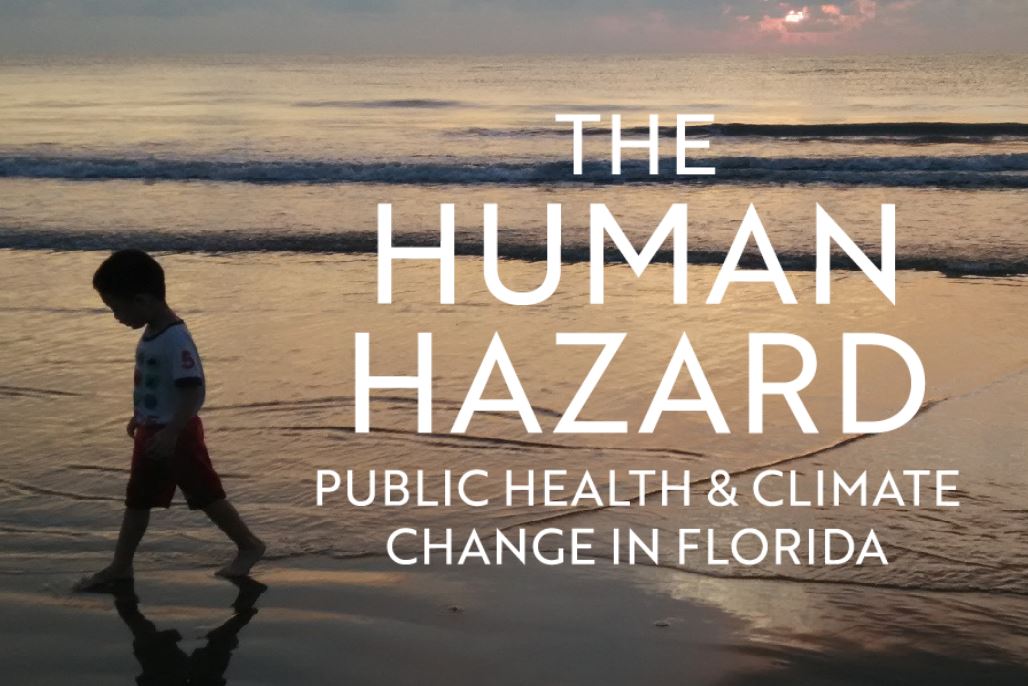 Students in the University of Florida's environmental journalism class spent their spring semester on an in-depth report on climate change and public health in Florida -- The Human Hazard -- now published in full on WUFT.ORG, the UF College of Journalism and Communications' public media platform. The four-part series, which included stories on the expansion of vector-carrying mosquitoes, rising heat-related hospitalizations, and other public-health trends, found that vulnerable populations are particularly susceptible to these risks, now amplified by coronavirus as basic programs have been suspended to contend with the emergency. FCI affiliate faculty member Cynthia Barnett taught the class, beginning the semester with lectures and database workshops by Florida Climatologist David Zierden and other experts. The College of Journalism is also a member of the Florida Climate Reporting Consortium, which picked up some of the stories in major media outlets in Tampa and Miami.
Students in the University of Florida's environmental journalism class spent their spring semester on an in-depth report on climate change and public health in Florida -- The Human Hazard -- now published in full on WUFT.ORG, the UF College of Journalism and Communications' public media platform. The four-part series, which included stories on the expansion of vector-carrying mosquitoes, rising heat-related hospitalizations, and other public-health trends, found that vulnerable populations are particularly susceptible to these risks, now amplified by coronavirus as basic programs have been suspended to contend with the emergency. FCI affiliate faculty member Cynthia Barnett taught the class, beginning the semester with lectures and database workshops by Florida Climatologist David Zierden and other experts. The College of Journalism is also a member of the Florida Climate Reporting Consortium, which picked up some of the stories in major media outlets in Tampa and Miami.
 The Federal Emergency Management Agency (FEMA) has released the publication, Building Community Resilience with Nature-Based Solutions. The key goal of this guide is to help communities identify and engage the staff and resources that can play a role in building resilience with nature-based solutions. This guide defines nature-based solutions as sustainable planning, design, environmental management, and engineering practices that weave natural features or processes into the built environment to build more resilient communities. While this guide uses the term nature-based solutions, other organizations use related terms, such as green infrastructure, natural infrastructure, or Engineering with Nature®, a program of the U.S. Army Corps of Engineers. The focus of this guide is local communities, but many of the ideas and advice may also apply to state, territorial, and tribal governments.
The Federal Emergency Management Agency (FEMA) has released the publication, Building Community Resilience with Nature-Based Solutions. The key goal of this guide is to help communities identify and engage the staff and resources that can play a role in building resilience with nature-based solutions. This guide defines nature-based solutions as sustainable planning, design, environmental management, and engineering practices that weave natural features or processes into the built environment to build more resilient communities. While this guide uses the term nature-based solutions, other organizations use related terms, such as green infrastructure, natural infrastructure, or Engineering with Nature®, a program of the U.S. Army Corps of Engineers. The focus of this guide is local communities, but many of the ideas and advice may also apply to state, territorial, and tribal governments.
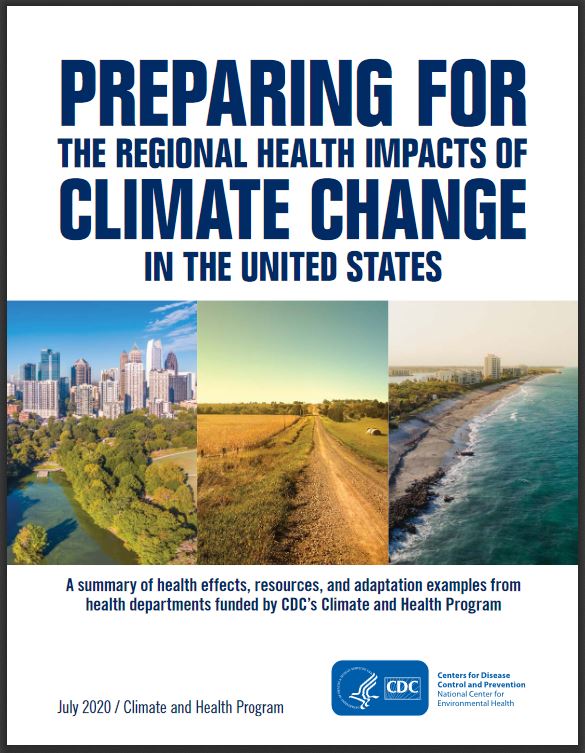 The CDC has published a new document Preparing for the Regional Health Impacts of Climate Change in the United States. The publication describes the various health impacts climate change will have on different regions of the United States, actions taken by the CDC Climate and Health Program's health department partners to prepare for and respond to climate change in their communities, and relevant tools and resources.
The CDC has published a new document Preparing for the Regional Health Impacts of Climate Change in the United States. The publication describes the various health impacts climate change will have on different regions of the United States, actions taken by the CDC Climate and Health Program's health department partners to prepare for and respond to climate change in their communities, and relevant tools and resources.
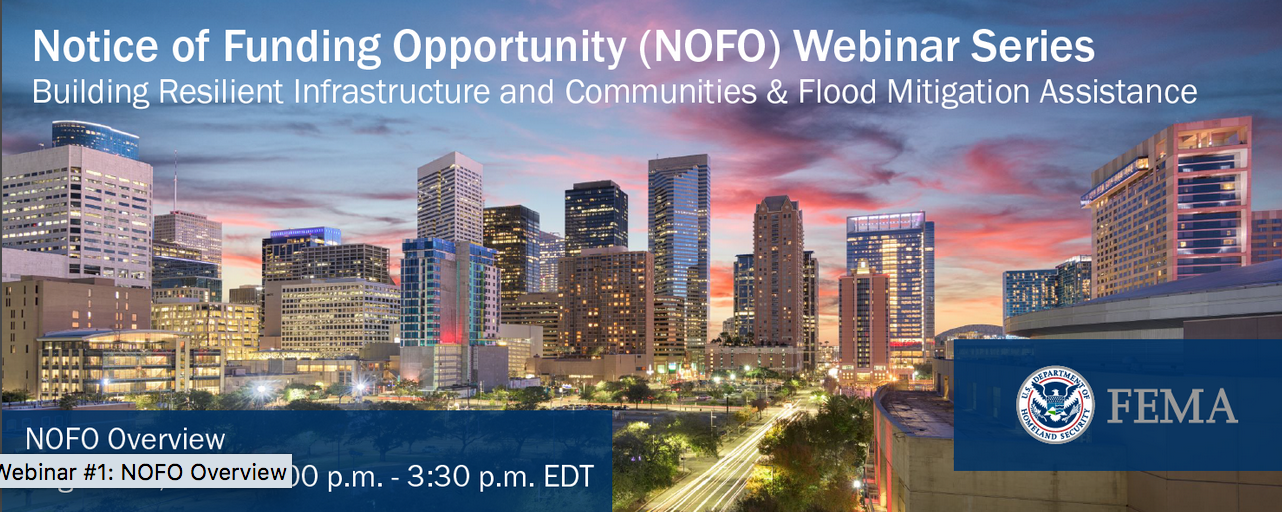
The Federal Emergency Management Agency (FEMA) has announced the Notice of Funding Opportunities (NOFOs) for the Fiscal Year 2020 Flood Mitigation Assistance (FMA) grant program and the new Building Resilient Infrastructure and Communities (BRIC) pre-disaster mitigation grant program. The BRIC Program will support states, local communities, tribes and territories as they undertake hazard mitigation projects, reducing the risks they face from disasters and natural hazards. BRIC is a new FEMA pre-disaster hazard mitigation program that replaces the existing Pre-Disaster Mitigation (PDM) program.
This year there is $660 million available for the FMA and BRIC programs combined. There is $160 million available in funding for FMA and $500 million for BRIC. The application period opens on September 30, 2020.
The article "Roads to Nowhere in Four States: State and Local Governments in the Atlantic Southeast Facing Sea-Level Rise", an assessment of coastal communities facing sea level rise and flooding co-authored by FCI affiliate Thomas Ruppert with Florida Sea Grant, has received further recognition. In addition to being selected as one of the top 4 environmental law articles by Vanderbilt Law and the Environmental Law and Policy Annual Review (ELPAR), the article was recognized as one of the top 15 environmental law articles of the year by the Thomson Reuters/West Publishing 2020 Land Use & Environment Law Review. "Roads to Nowhere in Four States" is the only article appearing in both the top 7 finishers in the Vanderbilt Law and ELPAR award and the top 20 in the Thomson Reuters/West Publishing 2020 Land Use & Environment Law Review.
Environment Law Review.
In addition, the "Coastal Conundrum" podcast, part of the American Shoreline Podcast Network, released the "Road to Nowhere-The Legal Issues Behind Climate Adaptation" podcast on August 12. The podcast features lead author Shana Jones, of Georgia Sea Grant & Vinson Institute for Government, and Thomas Ruppert discussing the legal issues addressed in the article. Listen to this insightful podcast as well as other podcasts on the American Shoreline Podcast Network.
 By invitation of the Risk Management and Decision Processes Center at the University of Pennsylvania's Wharton School, Thomas Ruppert, with Florida Sea Grant, contributed to the fifth Digital Dialogue on "Scaling up Coastal Ecosystem Protection." He joins thirteen other experts to discuss financial measures and policies that are most successful for scaling up coastal ecosystem protection. His segment is a drastically shortened version of the book chapter "Take Out the Trash When You Leave: Cleaning Up Properties Abandoned to Rising Seas," which will appear in the forthcoming book "A Blueprint for Coastal Adaptation" by Island Press. Digital Dialogues, hosted by the Risk Management and Decision Processes Center at the University of Pennsylvania's Wharton School, are short and concise summaries of policy innovations addressing large, critical problems facing society.
By invitation of the Risk Management and Decision Processes Center at the University of Pennsylvania's Wharton School, Thomas Ruppert, with Florida Sea Grant, contributed to the fifth Digital Dialogue on "Scaling up Coastal Ecosystem Protection." He joins thirteen other experts to discuss financial measures and policies that are most successful for scaling up coastal ecosystem protection. His segment is a drastically shortened version of the book chapter "Take Out the Trash When You Leave: Cleaning Up Properties Abandoned to Rising Seas," which will appear in the forthcoming book "A Blueprint for Coastal Adaptation" by Island Press. Digital Dialogues, hosted by the Risk Management and Decision Processes Center at the University of Pennsylvania's Wharton School, are short and concise summaries of policy innovations addressing large, critical problems facing society.
- PBS Digital Series "Global Weirding", with Dr. Katharine Hayhoe of Texas Tech University. The series includes over 30 short videos on a range of climate science topics, including a video on climate impacts in the Southeast U.S.
- YouTube channel that includes over 200 lectures, talks, and interviews given by Dr. Katharine Hayhoe.
- Denial 101x, which features conversations with dozens of top climate scientists from around the world who dive deeper into specific scientific topics.
- The Thinking Person's Guide to Climate Change, by Bob Henson, a climate blogger at Weather Underground and a former science writer at the National Center for Atmospheric Research.
- Fourth National Climate Assessment Volume I and Volume II, by the U.S. Global Change Research Program.
- Amazon reading list assembled by Dr. Katharine Hayhoe of Texas Tech University.
Seminole State College of Florida now offers a fully online post-baccalaureate certificate in Sustainability Management. The certificate is open to anyone with a bachelor's degree from a regionally accredited institution. Sustainability has moved beyond a mere buzzword to become a growing industry with loads of career potential as more organizations are implementing sustainability programs as part of their business model. Through the Sustainability Management Certificate of Professional Preparation, bachelor's degree holders can enhance or build their skills with training that will allow them to help companies incorporate sustainability efforts into their business goals to benefit their bottom line, and the planet. Contact Dr. Chris Boehner at This email address is being protected from spambots. You need JavaScript enabled to view it..
 In Northeast Florida, a new resource is educating local stakeholders about coastal hazards and vulnerabilities. The "Regional Resilience Exposure Tool," licensed by the Northeast Florida Regional Council (NEFRC) and developed by Taylor Engineering, allows local residents, business owners, and government actors to determine if resources are exposed to specific coastal hazards. In addition to coastal flood layers, the tool features other data layers relating to demographic and social measures that can be visualized in a variety of ways.
In Northeast Florida, a new resource is educating local stakeholders about coastal hazards and vulnerabilities. The "Regional Resilience Exposure Tool," licensed by the Northeast Florida Regional Council (NEFRC) and developed by Taylor Engineering, allows local residents, business owners, and government actors to determine if resources are exposed to specific coastal hazards. In addition to coastal flood layers, the tool features other data layers relating to demographic and social measures that can be visualized in a variety of ways.
The Regional Resilience Exposure Tool (R2ET) is intended to function as a base-line resource for citizens, businesses, and governmental actors to kickstart conversations about sea level rise and emergency preparedness. Utilizing this tool, as well as other community engagement resources offered by the Northeast Florida Regional Council, local communities can have better-informed conversations about building a resilient future. The tool has been utilized to support data and analysis sections of local government comprehensive plans, and is currently being used to better inform the work of the Jacksonville City Council, Special Committee on Resiliency.
To check the exposure of a local community asset in Northeast Florida, visit the official webpage for the Regional Resilience Exposure Tool.

The UF Department of Soil and Water Sciences and UF/IFAS Extension Service recently released a new report about climate change in Florida in a reader-friendly, science-based Q&A format.
Some of the questions addressed in the publication include:
- How do we know the climate is changing?
- What are greenhouse gasses and where do they come from?
- Is climate changing in Florida, and what are the long-term projections?
- Why are sea levels rising?
The document stemmed from a project the team worked on last year with Thriving Earth Exchange. Residents and employees of the city of Hallandale Beach attended a forum with the aim to increase climate literacy for the city staff. At the forum, staff members had the opportunity to ask questions about climate change directly to scientists.
The announcement of the publication and the full pdf are both available online.
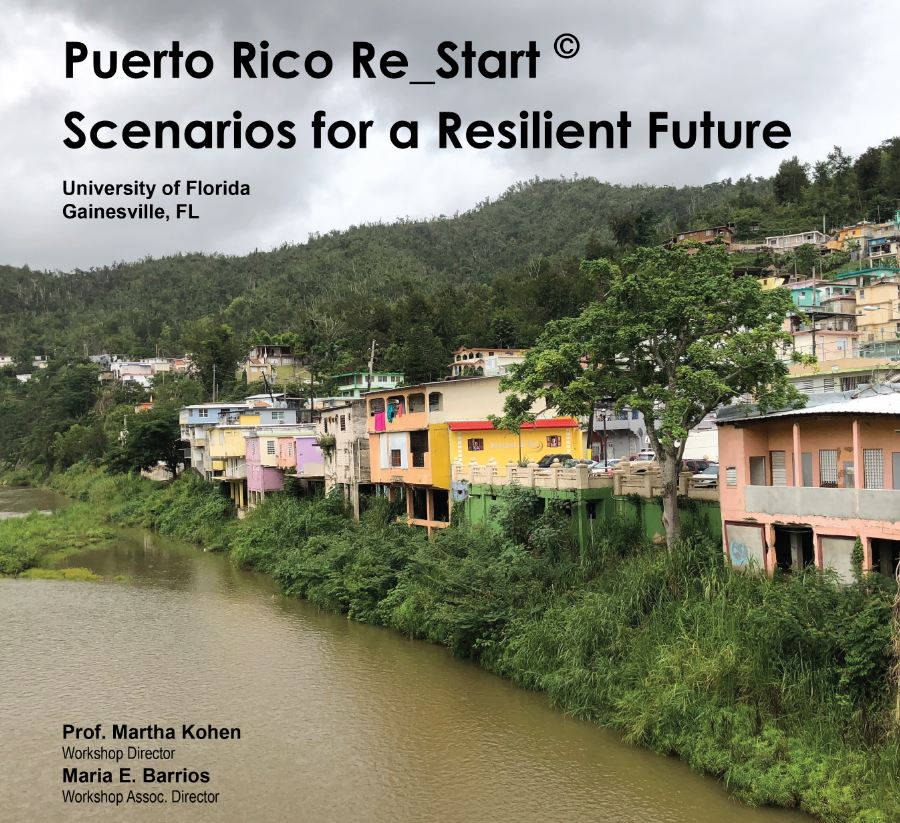 The University of Florida’s Center for Hydro-generated Urbanism (CHU) and the Polytechnic University of Puerto Rico, with sponsorship from the UNESCO Chair on Sustainable Urban Quality and Culture, released a new report titled “Puerto Rico Re_Start: Scenarios for a Resilient Future.” The report showcases the work resulting from the collaboration between CHU with Puerto Rico around multiple climate-related issues, in particular recent devastating hurricanes, sea level rise and flooding resilience, as well as infrastructure hardening. Inclusive, participatory workshops have involved scholars and students, professionals and administrators, NGOs and international partners. Save the date for the next workshop, “Puerto Rico Re-Start 4,” that is set for March 21 – 27, 2021. More info can be found HERE.”
The University of Florida’s Center for Hydro-generated Urbanism (CHU) and the Polytechnic University of Puerto Rico, with sponsorship from the UNESCO Chair on Sustainable Urban Quality and Culture, released a new report titled “Puerto Rico Re_Start: Scenarios for a Resilient Future.” The report showcases the work resulting from the collaboration between CHU with Puerto Rico around multiple climate-related issues, in particular recent devastating hurricanes, sea level rise and flooding resilience, as well as infrastructure hardening. Inclusive, participatory workshops have involved scholars and students, professionals and administrators, NGOs and international partners. Save the date for the next workshop, “Puerto Rico Re-Start 4,” that is set for March 21 – 27, 2021. More info can be found HERE.”
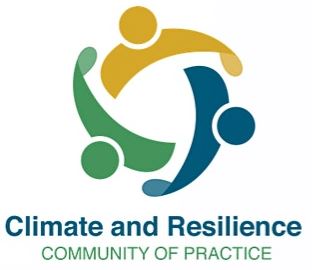 In 2009, the National Oceanic and Atmospheric Administration’s Gulf of Mexico Regional Collaboration Team and the four Gulf of Mexico Sea Grant Programs began working together to form the Climate Community of Practice. The Climate Community of Practice is setup to allow local decision-makers and extension, outreach and educators to work together to incorporate all types of coastal hazards into Gulf Coast communities comprehensive plans.
In 2009, the National Oceanic and Atmospheric Administration’s Gulf of Mexico Regional Collaboration Team and the four Gulf of Mexico Sea Grant Programs began working together to form the Climate Community of Practice. The Climate Community of Practice is setup to allow local decision-makers and extension, outreach and educators to work together to incorporate all types of coastal hazards into Gulf Coast communities comprehensive plans.
The Climate Community of Practice hosts a series of virtual sessions on various climate- and resilience-related topics, including the upcoming Neighborhood Resilience session taking place on October 14, 2020. The October session will take place from 1:00 pm to 2:30 pm CST and will feature three experts undertaking neighborhood resilience from multiple perspectives.
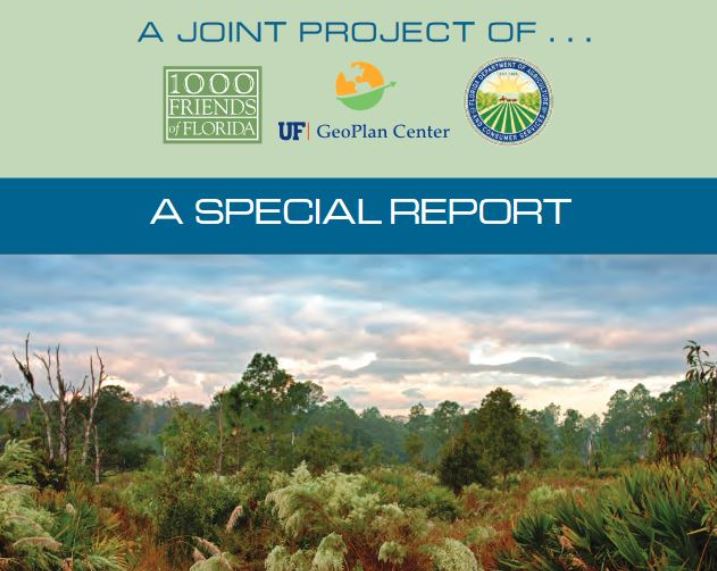 A team of faculty, staff, and students from the UF College of Design Construction and Planning, 1000 Friends of Florida, Florida Conservation Group, and Bureau of Business and Economic Research recently received funding from the Florida Department of Agriculture and Consumer Services for an update to the Florida 2070 Project, originally created by faculty emeriti Dr. Paul Zwick and Peggy Carr in collaboration with 1000 Friends of Florida. The update will identify a set of future growth scenarios for the State of Florida, which incorporate future sea level rise and population growth projections by the year 2070. For more information please contact Michael Volk (This email address is being protected from spambots. You need JavaScript enabled to view it.) or Dr. Tom Hoctor (This email address is being protected from spambots. You need JavaScript enabled to view it.).
A team of faculty, staff, and students from the UF College of Design Construction and Planning, 1000 Friends of Florida, Florida Conservation Group, and Bureau of Business and Economic Research recently received funding from the Florida Department of Agriculture and Consumer Services for an update to the Florida 2070 Project, originally created by faculty emeriti Dr. Paul Zwick and Peggy Carr in collaboration with 1000 Friends of Florida. The update will identify a set of future growth scenarios for the State of Florida, which incorporate future sea level rise and population growth projections by the year 2070. For more information please contact Michael Volk (This email address is being protected from spambots. You need JavaScript enabled to view it.) or Dr. Tom Hoctor (This email address is being protected from spambots. You need JavaScript enabled to view it.).
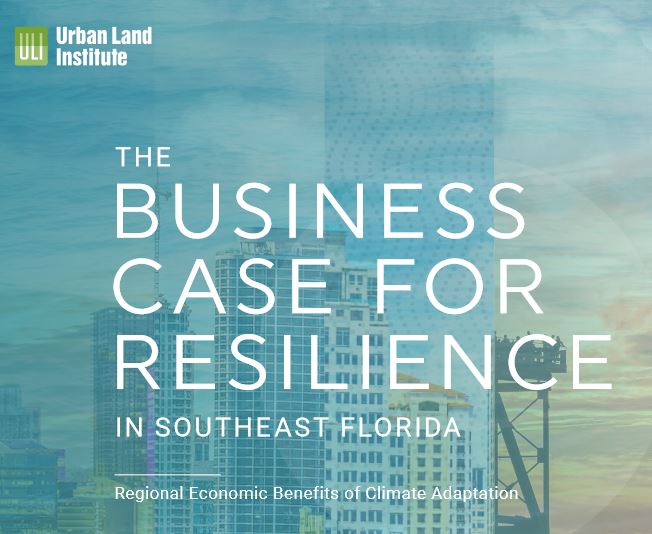 From the Miami-Dade County Office of Resilience:
From the Miami-Dade County Office of Resilience:
The Urban Land Institute (ULI) released a new report, The Business Case for Resilience in Southeast Florida: Regional Economic Benefits of Climate Adaptation. This cost-benefit analysis examines the economic risk of sea level rise in communities of the Southeast Florida Regional Climate Change Compact, including Miami-Dade, Broward, Palm Beach and Monroe counties. Based on a technical study completed by AECOM, one of the world’s leading infrastructure consulting firms, the report explicitly outlines the economic wisdom for significant public and private investment in resilient infrastructure now to prevent much more costly expenses in the future if no immediate action is taken. These investments will protect property against flooding while robustly driving job creation.
Economic hardships from potential dramatic declines in property values, damage from flooding, and lost tourism and tax revenue will amount to billions of dollars if steps are not taken now to transform our communities. However, the return on investment (ROI) from adaptation is positive, especially in Miami-Dade County. Building-level adaptations such as floodproofing, elevation, and the addition of permeable surfaces will generate $9 for every $1 invested and support 3,190 job years, which is one job per person each year, through 2040, or 22,660 job years through 2070. Community-wide adaptations, including green infrastructure, sea walls, and dune enhancement, will generate $5 for each $1 invested and support 15,200 job years through 2040, or 24,750 through 2070.
This ULI study supports the forthcoming Miami-Dade County Sea Level Rise Strategy, which will provide a clear roadmap for Miami-Dade County to make smart investments in resilience that create jobs and safeguard our community from future losses.
The ULI study was spearheaded and funded by a coalition of public and private partners, including Miami-Dade, Broward, Monroe, and Palm Beach counties; the Florida Department of Environmental Protection; the Beacon Council Foundation; Broward Workshop; Community Foundation of Broward; Greater Fort Lauderdale Chamber of Commerce; and Greater Miami Chamber of Commerce.
The Federal Emergency Management Agency (FEMA) announced a new policy that encourages communities to use environmentally friendly features such as wetlands for flood protection in addition to more traditional hard infrastructure like sea walls and levees. This new policy recognizes the value of natural and nature-based solutions for enhancing a community's resilience to flooding.
The new FEMA flood policy, released in September, eliminates the legacy benefit-cost ratio threshold requirement and allows ecosystem service benefits to be considered in all types of mitigation projects, regardless of the benefit-cost analysis value.
Read more about these changes in an article published by E&E News here.
Climate by Powers of 10 tells the climate story visually in images, maps, and graphs. Using data from recent, peer-reviewed sources, the website tracks the full sweep of climate history and possible futures and makes the information accessible to students and general readers. Looking both back and forward in time by powers of 10, the website allows users to choose a timescale to enter, from the year-to-year pace of weather disruption to the hundred-thousand-year cycles of ice ages, and hundred-million-year age of oil deposits. Glimpses into the future draw on IPCC projections, to help readers imagine worst-case and best-case scenarios. Each stop offers an evocative glimpse of life at the time, stories about changes in human and non-human life, a map, and a graph of key indices from that timescale to the present, for example over decades, centuries, millennia, or millions of years.
The website offers an entry into climate data for those just learning about the crisis we face, as well a ready, visual reference for those already familiar with the contours of the climate situation. Readers are invited to enter at any point in the narrative, compare maps and graphs across timescales, and to find their own way toward a meaningful understanding of the data.
If the Legislature approves the new program, “Resilient Florida” will use revenues from the state documentary stamp tax to pay for the debt service on $1 billion in bonds for projects that address the impacts of climate change.

CABI Agriculture and Biosciences is soliciting research manuscripts and novel contributions to a special collection entitled: Co-Benefits and Tradeoffs to Food Security from Mitigation and Adaptation in Agriculture
Special Collection Description:
Research at the nexus of climate mitigation and climate adaptation in agriculture remains challenging owing to both data and modeling limitations as well as the multi-scale analyses and stakeholder engagement required. Nevertheless, as the impacts of climate change intensify, there is an urgent need to close these science and policy gaps with rigorous analyses of how, and under what conditions, simultaneously pursuing agricultural adaptation and mitigation could provide valuable co-benefits and/or create trade-offs for food security, environmental change, and other important societal challenges. To fill these gaps, CABI Agriculture and Biosciences solicits high-quality manuscripts on (but not limited to):
• The data, models, and tools needed to evaluate agricultural mitigation and adaptation and subsequent co-benefits across biophysical and/or human (e.g., socio-economic) dimensions at multiple temporal and spatial scales
• Ongoing regional projects and case studies around the world that provide empirical bases to assess co-benefits stemming from combined mitigation and adaptation in agriculture
• Research addressing the socio-economic benefits and trade-offs, as well as the timescales of realizing mitigation and adaptation co-benefits
• Research on the science-policy links and policy implications of agricultural adaptation and mitigation co-benefits,
e. g., related to the development of national climate policies and commitments
The submission deadline is November 30, 2021
A team of scientists from the University of Florida hopes to address the invasive species problem by predicting how invasive species will move and migrate over the next 50 years as climate change, urbanization and other factors reshape the landscape.
Brett Scheffers, assistant professor at UF and the project’s principal investigator, said most of Florida’s invasive species are located in South Florida — but climate change and other trends could push these animals north.
For Immediate Release: April 16, 2021
Contact: Governor’s Press Office, (850) 717-9282, This email address is being protected from spambots. You need JavaScript enabled to view it.
Lakeland, Fla. – Today, Governor Ron DeSantis announced that more than $148 million has been awarded to communities through the Florida Department of Economic Opportunity’s (DEO) Rebuild Florida Mitigation General Infrastructure Program. The program, administered by DEO, allows local governments to develop large-scale infrastructure projects to make communities more resilient to future disasters.
“My administration remains committed to providing the resources necessary for Florida communities to build back stronger and be more resilient to future storms,” said Governor DeSantis. “This transformational mitigation funding will go a long way in helping Florida’s communities invest in their futures through critical infrastructure improvements.”
“This Lake Bonnet project is a perfect example of government working well,” Representative Scott Franklin said. “It is a model for what success looks like in a public, private partnership that will help a needed community, clean up a lake ecosystem and provide a new park that the entire Lakeland community can enjoy. It is a shining example of government and the private sector at all levels, working together on behalf of our community. I applaud Governor DeSantis for his support of this project and thank everyone at every level who has supported the vision for this project and contributed to this momentous occasion.”
The funds are allocated to the state through the U.S. Department of Housing and Urban Development’s (HUD) Community Development Block Grant – Mitigation (CDBG-MIT) program formed in response to the 2016 to 2017 presidentially declared disasters.
“Under Governor DeSantis’ strong leadership, our state continues to provide investments to ensure the resiliency of Florida communities,” said DEO Executive Director Dane Eagle. “The Rebuild Florida Mitigation General Infrastructure Program provides storm-impacted communities the opportunity to complete large, high-impact infrastructure projects that will pay dividends for future generations.”
DEO is awarding the following communities funding through the Rebuild Florida Mitigation General Infrastructure Program:
- Broward County ($6,250,000) – to construct an interconnect between the Broward County Reuse Facility and the City of Pompano Beach's OASIS Reuse facility.
- City of Arcadia ($4,823,579) – to widen a stormwater tributary to provide additional storage during storm events to better control flood volume.
- City of Avon Park ($670,623) – to improve the existing potable water system through replacement of asbestos pipes with PVC piping, adding additional bore to improve water pressure, and to install an upgraded chlorine system.
- City of Doral ($1,000,000) - to reduce the frequency and severity of stormwater flooding by providing a positive-gravity drainage outfall discharging into the NW 58th Street canal.
- City of Fort Lauderdale ($10,500,000) – to replace aging and undersized stormwater infrastructure with new infrastructure systems that help with neighborhood flooding issues and provide better water quality treatment prior to releasing into the intracoastal waterway.
- City of Key West ($3,099,159) – to install tide valves at 40 stormwater outfall points of discharge to address saltwater flooding of roadways, sidewalks, and low-lying properties caused by high tides.
- City of Key West ($6,336,165) – to design and construct a pump-assist injection well to address flooding in a low-lying area that collects significant runoff.
- City of Lakeland ($42,986,390) – to establish a multi-component project in partnership with Bonnet Springs Park which focuses on increasing flood storage capacity to the drainage basin by improving the stormwater infrastructure and watershed quality.
- City of Lauderhill ($3,125,215) – to complete water and sewer line improvement projects.
- City of Miami ($13,497,843) – to retrofit portions of existing seawall, construct new sea wall sections, and other coastal resiliency improvements.
- City of Miami ($1,216,963) – to implement roadway resiliency improvements to NW 17th Street, between NW 27th Avenue and NW 32nd Avenue. Improvements include the installation of a drainage system, exfiltration trench, storm inlets, accessibility ramps, and swales.
- City of North Miami Beach ($6,000,000) – to implement system-wide improvements to the sewer collection system that protects public health and natural water resources.
- City of North Miami Beach ($11,700,000) - to enhance the water transmission and distribution system to improve water quality, fire flow capacity, reliability, and resiliency.
- City of Orlando ($2,850,000) – to develop six resiliency hubs that will provide services to low- and moderate-income communities in the recovery phase of a disaster.
- City of Sebring ($2,605,428) – to complete fire protection resiliency, water quality, and water conservation infrastructure improvements.
- City of Sebring ($3,515,580) – to harden facilities that are part of the cities sanitary sewer collection system.
- City of West Palm Beach ($16,764,610) – to build resilient seawalls, improve storm water quality, and develop living shorelines, pedestrian hardscaping, and native landscaping.
- DeSoto County ($3,757,012) – to replace decaying drainage system infrastructure to significantly increase service life and reduce the possibility of flooding.
- DeSoto County ($3,273,575) – to repair a bridge used as an evacuation route during storms.
- Osceola County ($4,689,320) – to modify and adapt existing drainage elements to substantially reduce repetitive flooding.
With a total allocation of $475,000,000, the Rebuild Florida Mitigation General Infrastructure Program will provide two additional rounds of funding in the future to communities designated by HUD or the state as Most Impacted and Distressed (MID) by Hurricanes Hermine, Matthew, and Irma.
The Department is the governor-designated state authority responsible for administering all U.S. Department of Housing and Urban Development (HUD) long-term recovery funds awarded to the state. Rebuild Florida uses federal funding for Florida’s long-term recovery efforts from the devastating impacts of natural disasters. For more information, visit RebuildFlorida.gov.
 A record 137 participants joined a webinar on 2020 Hurricane Season Impacts on Water Management in Florida hosted by the Florida Water & Climate Alliance (FloridaWCA) and the UF Water Institute on April 7, 2021. It was the FloridaWCA’s 25th webinar/workshop since it was founded in 2010. Participants came from varied backgrounds and agencies including water utilities, Water Management Districts, government agencies, non-governmental organizations, universities and consulting firms.
A record 137 participants joined a webinar on 2020 Hurricane Season Impacts on Water Management in Florida hosted by the Florida Water & Climate Alliance (FloridaWCA) and the UF Water Institute on April 7, 2021. It was the FloridaWCA’s 25th webinar/workshop since it was founded in 2010. Participants came from varied backgrounds and agencies including water utilities, Water Management Districts, government agencies, non-governmental organizations, universities and consulting firms.
The webinar featured a panel session to discuss the 2020 hurricane season, impacts to utilities and water management districts, and the challenges associated with disaster and crisis communication in Florida related to climate change. Moderated by Dr. Vasu Misra (Florida State University) the session featured presentations by Dr. Tirusew Asefa (Tampa Bay Water), Dr. Michael Kozar (Risk Management Solutions), Dr. Angie Lindsey (University of Florida), and Dr. Carolina Maran (South Florida Water Management District). Additional webinar presentations featured two different projects that have the goal of co-producing climate science with stakeholders: Dr. Esther Mullens (University of Florida) presented on a national project to predict rainfall extremes at subseasonal to seasonal periods (PRES2iP); and Dr. Tracy Irani (University of Florida) presented on a Florida-specific project to improve seasonal forecasts for use in water utility decision making by integrating NASA earth systems data.
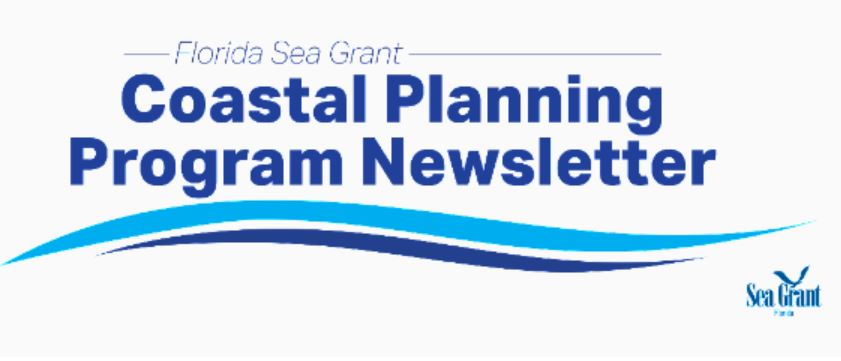
On April 26, 2021, Florida Sea Grant's Coastal Planning Program Newsletter put out a special edition, Legislative Update on Resilience & Sea-Level Rise, to help make sense of some new legislation:
Florida Legislature Acts on Resilience, Sea-Level Rise, and Flooding but not on Climate Change; Sends Mixed Signals to Local Governments about Creating More Vulnerability
On April 8, 2021, the Florida Legislature passed “An Act Relating to Statewide Flooding and Sea Level Rise Resilience” (SB 1954/HB 7019) (referred to hereafter as the Resilience Act or Act). This and related bills contain a number of positive changes to Florida Statutes that will help Florida better understand the risks and costs to Florida of sea-level rise (SLR). While this and related bills that have passed this session, as described below, indicate a sea change for Florida’s Legislature on SLR, this effort would be stronger with a focus on the causes of SLR and increased flooding.
The Resilience Act clearly articulates the risks of SLR and increased flooding, whether due to more severe rain events, surge, or SLR. The Act establishes the “Resilient Florida Grant Program” in the Florida Department of Environmental Protection (DEP). The program can provide grants to local governments and regional resilience entities to fund resilience planning, vulnerability assessments for flooding and SLR, the development of adaptation projects, plans, and policies to address flooding and SLR threats, and projects to adapt critical assets to the effects of flooding and SLR. Grants may also be used for necessary data development and collection. The Act sets out minimum requirements for the data included in funded vulnerability assessments. Importantly, the Act requires that all such data be in specific formats and be submitted to DEP for inclusion in a statewide database.
This overall collection of local data will then assist the State accomplish the Resilience Act requirement that DEP develop a statewide flood vulnerability and SLR data set that will allow creation of a statewide flood vulnerability and SLR assessment. This includes development of statewide SLR projections (which are noted to not supersede regionally adopted projections) by the State’s Chief Science Officer. The Act details an extensive list of information to include in the statewide vulnerability assessment, such as information from previous local vulnerability assessments which meet specified information protocols. The first assessment is due for completion on July 1, 2023 whereas the statewide dataset on which it is based is due July 1, 2022.
The Act requires DEP to develop a yearly Statewide Flooding and Sea Level Rise Resilience Plan on a 3-year planning horizon. This plan consists of ranked projects that address flooding and SLR in coastal or inland communities and is submitted to the Governor and Legislature. The Act details the criteria and ranking percentages to be used by DEP in ranking the projects submitted by municipalities, counties, or regional resilience entities.
The Act establishes the Florida Flood Hub for Applied Research and Innovation at the University of South Florida College of Marine Science. The Hub is to coordinate and support applied research and innovation and to address flooding and SLR challenges in Florida. The Florida Flood Hub and USF serve as the lead institution for engaging other academic and research institutions, private partners, and financial sponsors on related efforts. Related bill SB 2514 authorizes DEP to provide funding to USF for operational and administrative costs for the Flood Hub.
Section 3 of the Act adds “inland and coastal flood control” to the Office of Economic and Demographic Research’s required annual assessment of Florida’s water resources and conservation lands.
The Resilience Act forms part of a larger initiative by the 2021 Legislature in Florida to address flooding and SLR. For example, the focus on specifying the types and formats of data to be collected and used and submitted to DEP for use at the state level is part of a larger effort by the State of Florida to capture more granular, local-level data on risk and vulnerabilities and the costs to address them. For example, HB 53 contributes to this, albeit on a shorter timescale, with wastewater and stormwater. HB 53 would require counties, municipalities, and special districts to develop detailed analyses and plans for their wastewater and stormwater facilities over the next 20 years. These analyses and their data sets are then compiled by the relevant counties and supplied to the State Office of Economic and Demographic Research. Additionally, HB 53 would have this information integrated into the new statewide assessment that is part of SB 1954.
Seeing Florida’s Legislature getting serious to address the impacts of flooding and SLR is good news. But is this sufficient?
First, and central to the entire conversation, neither SB 1954 nor any related bills directly address climate change (CC) as the driver for SLR and the increased intensity rain events causing increased inland and coastal flooding. This represents a failure to address the root causes of SLR and increased flooding. This is akin to a homeowner with a roof leak collecting data on how much water is leaking in, predicting where water might leak next, and estimating how many buckets and of what size are needed in the future. But doing all this without directly addressing the leaking roof. While we have already “baked in” some sea-level rise into our future, we still must reduce greenhouse gases to minimize the increasing rate of SLR and the total amount of SLR we cause by emitting greenhouse gases.
Second, legislative work on SLR so far focuses on infrastructure fixes to SLR and increased flooding. This may be a tenable approach in the short term, but over medium- and long-term time horizons, this will not be feasible for all communities. As Monroe County (a.k.a. the Florida Keys) has discovered with extensive data gathering and analysis in its efforts to understand the vulnerability of its roads: raising all the roads to keep them as dry as people are accustomed to will be too expensive for the County to maintain over the long-term. Similar realities will arise in other low-lying places for existing infrastructure beyond just roads. Fortifying infrastructure to address SLR and precipitation-driven increases in flooding buys us time, but we still need longer-term strategies and options. For example, when do we consider the merits of hardening infrastructure now versus investing those funds in planning for alternative solutions at the community level? Questions such as this admit of no easy answers, but sooner or later we will have to answer such difficult questions. The sooner we begin to consider them, the more options we will have and at costs we are more likely to be able to bear.
Third, the Resilience Act is linked financially to SB 2521 and SB 2514, both of which have now passed the Legislature. SB 2521 reduces the documentary tax stamp moneys that flow to the State Housing Trust Fund. Florida already has severe housing affordability problems. SLR and flooding exacerbate these challenges by driving gentrification in higher elevation areas in urban areas, with the Miami area often referenced as an example. Thus, even as SLR and increased flooding contribute to affordable housing problems, SB 2521 redirect monies from the State Housing Trust Fund to the “Resilient Florida Trust Fund” created by SB 2514 that will pay for the Resilience Act. Instead of directly addressing affordable housing, these monies will now be used to fund the new programs in SB 1954, such as the Resilient Florida Grant Program, the Statewide Flooding and Sea-Level Rise Resilience Plan, providing grants to regional resilience coalitions, and for administrative and operational costs of the Florida Flood Hub.
Fourth, even as the Legislature focuses on data gathering and funding projects to address SLR and increased flooding, the Legislature is sending mixed signals to local governments. To understand these mixed signals, a little background: those working in the fields of SLR and flooding understand three basic things: 1) Most of the risk from SLR and flooding comes from how and where we choose to develop (to paraphrase a famous quote: Floods are acts of God; flood losses are largely acts of people); 2) while individuals suffer greatly when disasters strike vulnerable areas, the public also pays the bill through massive federal spending to address the foreseeable damage that occurs due to our development decisions in hazardous areas (e.g. hundreds of billions of dollars in federal supplemental spending over the last years for disasters and forgiveness of tens of billions of dollars of debt of the National Flood Insurance Program); and 3) the most powerful tools local governments have to avoid creating more vulnerabilities to hazards such as SLR and flooding include planning, zoning, and development restrictions/conditions.
Yet even as these three points are clear, moving rapidly through the legislative process is SB 1876, an Act Relating to Relief from Burdens on Real Property Rights. This bill proposes significant changes to the Bert J. Harris, Jr., Private Property Rights Protection Act that would decrease the willingness and ability of local governments to make changes that prevent creation of more vulnerability (and the related public costs) in areas currently at risk of chronic flooding or that that will become so due to SLR and climate change. For example, SB 1876 would make it possible for property owners who have never applied for a permit, had any development plans, or maybe never even contemplated further development, to sue a local government for “damages” caused by the mere adoption of new rules or regulations on property. This could lead to attorneys watching for new local government and directing advertising to owners of “affected” properties. Since the bill also makes it easier for a prevailing property owner in a lawsuit to recover attorney’s fees (and for a longer time period) than for a prevailing defendant government, this bill would encourage more lawsuits that would decrease the willingness and ability of local governments—or the State—to slow or stop the creation of additional vulnerability to SLR and increased, climate-change-driven flooding. A number of other changes in the bill also place greater burdens and risks or offer less protections to government entities that might utilize planning, zoning, and development restrictions to prevent creation of more vulnerability to current and future risks. Thus, the proposed changes to the Bert Harris Act discourage any new rules or regulations through increased legal and financial risks to local governments of doing so. In turn, this means that property owners and developers will have more “rights” to create more of the very vulnerabilities that the Legislature is spending so much money to address in the Resilience Act.
In the past, Florida was a leader on land use planning and climate change mitigation through statewide policies focused on energy, conservation, and clean, renewable power. But most of those state laws have been repealed. Now, the Legislature has acted on some of the key impacts of climate change—increased flooding, higher storm surge, and SLR—but not the root causes of these impacts, all while advancing changes that make it more difficult for state or local government to avoid the private creation of additional vulnerability. The impacts of increasing vulnerability will, in large part, be borne by citizens and taxpayers at the local, state, and national levels.

Carolyn Cox, Coordinator of the FCI, used her model for experiential courses in Florida to help design a 5-university challenge around sea level rise impacts to the island of Nantucket. Through the UF Preservation Institute Nantucket program partnership, the FCI was able to provide this opportunity for 18 students (14 from UF and 4 from U Miami) from Florida to travel to Nantucket to present their work to the community and partner universities. This collaborative model also enabled all teams to learn from each other’s approach, innovations, and areas of strength. FCI plans to use this multi-institutional model in additional Florida cities.
Students studying architecture, landscape design and urban sustainability at five East Coast universities (U Florida, U Miami, Northeastern, Yale, and Harvard) spent the past five months in a semester-long course developing innovative and adaptive designs and proposals for the island and its year-round and seasonal residents and visitors. Due to the pandemic, the students never set foot on the island. But through a robust academic curriculum, an impressive 10-week speaker series and the partnership of more than 20 local advisors, students truly came to understand the coastal, geological and cultural history of Nantucket as well as the value systems of the community. On June 2, the students presented their final designs to the community, in an event that will inspire coastal communities everywhere to imagine a resilient and adaptive future in the face of sea level rise. Visit the event website below to see designs posted soon.
Nantucket is one of hundreds of U.S. cities and towns threatened by sea level rise. By 2100, much of Nantucket’s historic downtown is projected to regularly be inundated with as much as nine feet of water. Rather than run from rising seas, the Envision Resilience Nantucket Challenge called on teams of graduate and undergraduate students to design adaptive solutions for residents and businesses to learn to live with water.
 Lacey Lingelbach (pictured in photo on right), the first Florida Student Climate Fellow at FCI, has been completing her Rural Florida Climate Connections Project since April. This project shares her research on barriers to climate action in rural inland Florida and solutions for it with various stakeholders. Through her Climate Roadshow, she has been speaking about local climate projections and solutions to rural Rotary Clubs, Kiwanis Clubs, and Chambers of Commerce in North Florida. She also plans to write opinion editorials on these trends and actions for local newspapers such as the Tallahassee Democrat, Jefferson County Journal, and Valdosta Daily Times.
Lacey Lingelbach (pictured in photo on right), the first Florida Student Climate Fellow at FCI, has been completing her Rural Florida Climate Connections Project since April. This project shares her research on barriers to climate action in rural inland Florida and solutions for it with various stakeholders. Through her Climate Roadshow, she has been speaking about local climate projections and solutions to rural Rotary Clubs, Kiwanis Clubs, and Chambers of Commerce in North Florida. She also plans to write opinion editorials on these trends and actions for local newspapers such as the Tallahassee Democrat, Jefferson County Journal, and Valdosta Daily Times.
Finally, she is reaching out to those outside of these communities that can provide them support or further explore the gap in rural climate action in Florida, such as the Florida Climate Institute. You can find her undergraduate research thesis entitled “Beyond Rising Seas: Understanding Climate Planning Challenges in Rural Inland Florida” here.
During her time at UF, Lacey has earned a bachelor’s degree in environmental science and two minors in public leadership and economics. After her involvement with local activism for the toxic algae blooms in Lake Okeechobee in 2016, she was inspired to pursue this degree where she has primarily focused on water and climate policy at the local level. During her time, she has interned with UF/IFAS Extension, the City of Gainesville, and the Martin County Growth Management Department. She has also been heavily involved in civic engagement activities through her volunteering with the FL YMCA Youth In Government program and UF’s Bob Graham Center for Public Service.
FCI at UF has awarded 6 exceptional students who have proposed original research ideas that they will pursue beginning this summer. Each student has included a problem statement, proposed solutions, broader impacts assessment, and a plan for impacting Florida communities through outreach and communications. 24 proposals were submitted from almost every college on campus showing the magnitude of climate issues facing Florida.
Check out the list of awardees below, including our first fellow spotlight on Lacey Lingelbach!
- Emily An, Marine Science major in Geological Sciences, Ellen Martin mentor, Sea level rise and ice sheet outreach to student groups, high schools, and 4-H
- Cameron Brousse, Sustainability and the Built Environment major, Hal Knowles mentor, Scaling up energy outreach programs for FL counties
- Lacey Lingelbach, Ag Ed and Communications major, Cynthia Barnett mentor, Rural FL Climate Connections Roadshow presentations and op-eds
- Ailee Odom, Natural Resource and Conservation major, Martha Monroe mentor, Developing climate materials in 4-H youth clubs
- Marlowe Starling, Journalism major, Brett Scheffers mentor, Using data visualization tools to communicate invasive species risks
- Umi Thorat, Computer Science major, Kathe Todd-Brown mentor, Carbon sequestration in coastal ecosystems and outreach
 In temperate climates, mosquitoes are generally inactive during the winter because temperatures are too cold, but as climate change makes winters shorter and warmer, scientists want to know how these shifts might affect mosquito activity. A new UF study shows that mosquitoes can adjust to rapid changes in temperature, indicating that mosquitoes normally dormant during winter may become active year-round due to climate change.
In temperate climates, mosquitoes are generally inactive during the winter because temperatures are too cold, but as climate change makes winters shorter and warmer, scientists want to know how these shifts might affect mosquito activity. A new UF study shows that mosquitoes can adjust to rapid changes in temperature, indicating that mosquitoes normally dormant during winter may become active year-round due to climate change.
The study’s authors conducted experiments with mosquitoes collected in and around Gainesville, a North Central Florida city on the dividing line between subtropical and temperate climates. The researchers say that insights from this study can help communities better prepare for the impacts of climate change as they relate to mosquitoes, which spread diseases that affect humans and animals.
You can read more on this study on Samantha Murray's UF/IFAS blog post.
 States across the US are undertaking the work to understand what it will take to get to carbon neutral. These efforts support Biden’s plan of 100% clean electricity by 2035 and net-zero emissions economy-wide by 2050. The US Energy Information Administration reports that in 2017 Florida was the third largest emitter of carbon dioxide (www.eia.gov). To support this goal, the Florida Climate Institute (FCI) is undertaking work to develop a state-wide greenhouse gas inventory and initiate net-zero action planning.
States across the US are undertaking the work to understand what it will take to get to carbon neutral. These efforts support Biden’s plan of 100% clean electricity by 2035 and net-zero emissions economy-wide by 2050. The US Energy Information Administration reports that in 2017 Florida was the third largest emitter of carbon dioxide (www.eia.gov). To support this goal, the Florida Climate Institute (FCI) is undertaking work to develop a state-wide greenhouse gas inventory and initiate net-zero action planning.
Led by Florida International University and University of South Florida, university faculty and students from across the FCI, and stakeholders from across the State, are contributing expertise and research support in greenhouse gas inventory sectors of energy, industrial processes and product use, agriculture, land use, land-use change and forestry, including wetlands, and waste; Florida economic trends; and negative emissions technologies (e.g., direct air capture, geological sequestration, BECCS, agricultural soils, blue carbon). As part of the project, we have awarded scholarships to seven graduate students affiliated with Florida International University, University of South Florida, University of Florida, Florida State University, University of Central Florida, and University of Georgia. The project is supported by the Environmental Defense Fund. A report is expected to be released in February 2022.
For more information, please contact This email address is being protected from spambots. You need JavaScript enabled to view it.or This email address is being protected from spambots. You need JavaScript enabled to view it..
 The Intergovernmental Panel on Climate Change (IPCC) released the first of three installments of the Sixth Assessment Report (AR6). The first installment is from Working Group I (WG1) and it discusses the physical science of climate change. Reports from Working Groups II (Impacts, adaptation, and vulnerability) and III (Mitigation of climate change) will follow in 2022.
The Intergovernmental Panel on Climate Change (IPCC) released the first of three installments of the Sixth Assessment Report (AR6). The first installment is from Working Group I (WG1) and it discusses the physical science of climate change. Reports from Working Groups II (Impacts, adaptation, and vulnerability) and III (Mitigation of climate change) will follow in 2022.
Part I of the new IPCC Sixth Assessment Report, The Physical Science Basis, updates the current scientific understanding of climate change, indicating that the impacts of climate change are largely happening the way scientists have expected. This report emphasizes the increasing confidence that scientists have that human activities increased CO2 concentrations and warmed and continue to warm our planet.
The full release, ready-to-use graphics, and other details can be found on the Climate Central website.
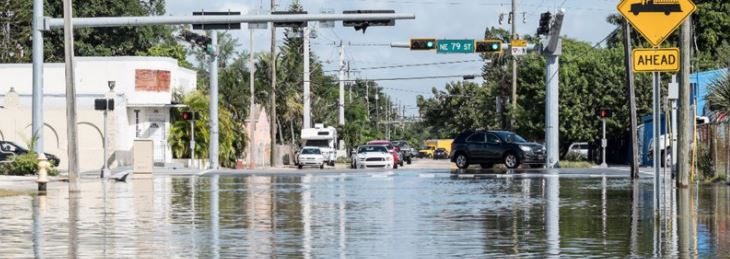
This article is from the Miami-Dade County website.
King Tides are the highest predicted high tides of the year. King Tides are technically called "perigean spring tides," but they occur in both the spring and fall seasons. In fact, the highest tides in southeast Florida occur in the fall, in part because the water is warmer and the seasonal winds drive water levels higher at that time of year.
When and where are the King Tides expected?
King Tides normally occur a few times per year and often cause nuisance flooding in coastal and low-lying areas. More severe flooding may result if King Tides coincide with bad weather conditions such as heavy rains, strong winds or big waves. However, sea level rise is causing these tides to happen more frequently, to last longer and extend further inland than in the past.
Based on the National Oceanic and Atmospheric Administration's tide predictions, King Tides will occur on the following dates in fall 2021:
- Sept. 9-11
- Oct. 5-11
- Oct. 20-21
- Nov. 3-9
- Dec. 2-7
Preparing for the King Tides
Most of the King Tide impacts are felt along the coast and in very low-lying areas near other water bodies. Residents who want to know which areas are impacted by the King Tides are encouraged to use the National Oceanic and Atmospheric Administration's Sea Level Rise Viewer. On this map you can zoom into Miami-Dade County or your neighborhood. When you click on the "flood frequency tab" you will see areas in red that are vulnerable to King Tide flooding.
Flooding can also obstruct access to roadways. If possible, move vehicles to higher ground before the King Tides begin and wash your vehicle down with fresh water after driving through salt water.
Additionally, follow these safety precautions:
- Do not walk through flood water if possible.
- If you do need to walk through flood waters follow good hygiene practices and wash your hands, clothes, and pets after.
- Do not drive through flooded areas - it is dangerous and can damage your vehicle. Find an alternative route.
- Boaters should be aware that high tides cause lower clearance under bridges - check the tide before leaving the dock.
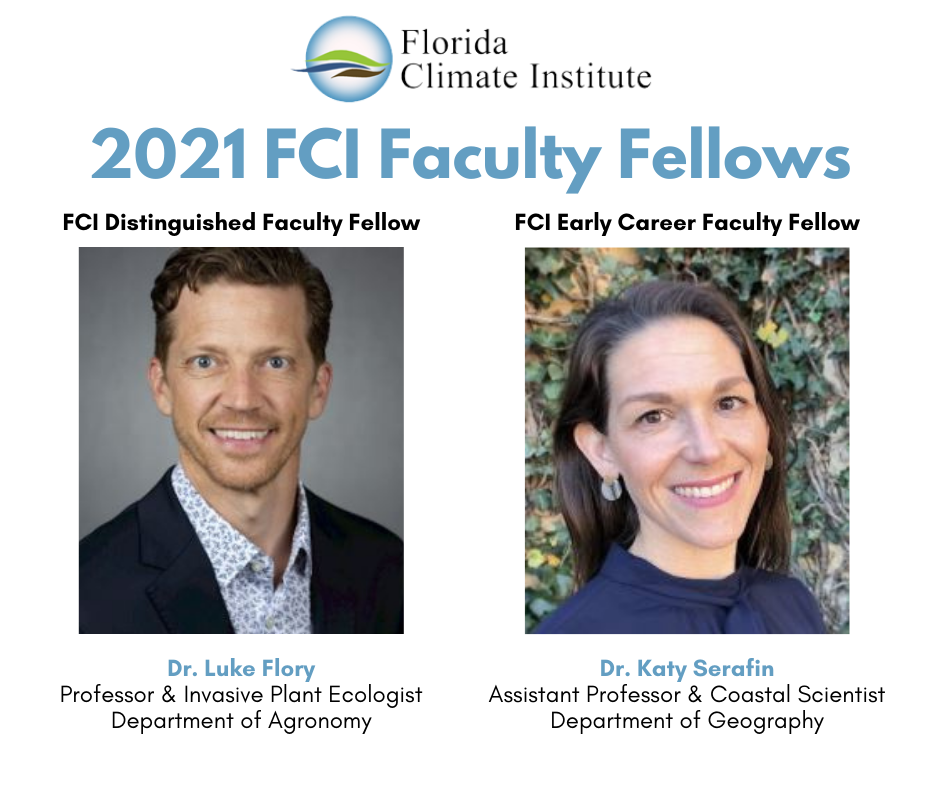
Congratulations to Dr. Luke Flory, Professor and invasive plant ecologist in the Department of Agronomy, for his selection as 2021 Florida Climate Institute Distinguished Faculty Fellow and Dr. Katy Serafin, Assistant Professor and coastal scientist in the Department of Geography, for her selection as 2021 UF Early Career Florida Climate Institute Faculty Fellow!
These awardees are being recognized for their outstanding contributions to interdisciplinary climate research, extension, and education programs, as well as their strong support of Florida Climate Institute Programs.
Dr. Luke Flory joined the Agronomy Department in 2011 as an invasive plant ecologist and has had remarkable achievements, an expanding national and international reputation as an expert and leader in invasive species ecology. He is responsible for investigating the mechanisms behind non- native species invasions, quantifying their ecological impacts, and examining how invasive species interact with other global change drivers such as climate change, emerging pathogens, and fire. Dr. Flory’s focus on invasion ecology is addressing one of the most critical problems faced by the state of Florida, the US, and the world.
Dr. Katy Serafin joined UF Geography in 2019 and over the past few years, her research has advanced the understanding of how processes such as waves, tides, and storm surge drive extreme coastal water levels in sandy beach and coastal river/estuarine environments. Investigation into the cascading impacts of sea level rise at UF by evaluating how the duration of nuisance or “sunny day” flooding events which have the potential to disrupt daily routines and put added strain on the human-built environment have been changing here in Florida and across the United States.
Stayed tuned for details on the date and format of the 2021 Faculty Fellows Celebration to honor this year’s FCI Faculty Fellows along with Water Institute Fellows Drs. Jiangxiao Qiu, Early Career and Lisa Krimsky, Distinguished Fellow.

The Florida Climate Institute’s Collaborative Climate Research Fellowship Program aims to provide opportunities for UF faculty to broaden their climate-related research scope and develop collaboration among the international faculty community. This fellowship helps foster the development of innovative, interdisciplinary research projects and publications that will help find solutions to the global, complex challenges facing society.
We are partnering again this year with the UF International Center’s Global Fellows Program to better connect our FCI climate fellow with a cohort of other early-career researchers.
Informational session:
Friday September 17, 2021 Noon to 1 pm (Large Conference Room, International Center – the Hub, 1765, Stadium Rd, Gainesville, FL 32611) or on Zoom https://ufl.zoom.us/j/7627585143
Funding:
A seed grant of $5,000 provides faculty an opportunity to lay the groundwork for conducting international climate-related research. Faculty must use these funds to cover expenses to travel to collect field data, to meet with international scholars, to access resources not available at UF, and to support any activity that advances climate research abroad.
Eligibility:
The program is open to all UF faculty who have a climate-related research assignment, regardless whether they are on a tenure track. The program is designed to support young scholars, those within the first 10 years of their academic career. In evaluating proposals, it is important for faculty to demonstrate that they have well thought out and clearly defined international research goals.
To apply:
Applications due October 21, 2021
In addition to the seed funding, the program offers a series of workshops, orientation and symposium that fellows must attend
- Application (no longer available)
- CV (3 pages max)
- Personal Statement of Interest (2 pages, 1-inch margins 11 – 12 pt. font)
- Letter of Support from Chair, Director, or Dean
- Letter of commitment from Mentor
Workshops
- Orientation: Friday, January 14, 2022, 1 – 3 pm
- Workshop 1: Friday, January 28, 2022, 9 – 11 am
Finding Funding to Support International Research - Workshop 2: Friday, February 11, 2022, 9 – 11 am
Preparing Proposals to Support International Research - Workshop 3: Friday, February 25, 2022, 9 – 11 am
Navigating the IRB, Export Controls, International Permits and Other Bureaucratic Hurdles - Workshop 4: Friday, March 18, 2022, 9 – 11 am
Broader Impacts – Measuring Scientific Merit and Impact on Society, Education and Outreach - Workshop 5: Friday, April 1, 2022, 9 – 11 am
International Partnerships and Agreements - Workshop 6: Friday April 15, 2022, 9 – 11 am
Engaging Students and Internationalizing the Curriculum, Study Abroad, Experiential Learning and More - Symposium: Friday, April 22, 2022, 9 am – 1 pm
· Complete an international research trip within one year.
· Identify and meet with an on-campus mentor who will provide guidance related to pursuing the international research project and other professional development endeavors during the program and beyond.
Previous fellows include:
2017-18: Stephanie Bohlman, UF School of Forest Resources and Conservation
In March 2018, Dr. Bohlman traveled to Panama to work with collaborators at the Smithsonian Tropical Research Institute on a manuscript using unmanned aerial vehicles to measure how tropical tree phenology responds to seasonal and interannual climate variation, developed an NSF proposal titled “Patterns, mechanisms, and consequences of variation in tropical forest plant phenology among species and environments in response to climate change” and presented two seminars: one on tropical tree phenology response to climate and environment, the other on using remote sensing to measure tree growth including response to growth to interannual climate variation.
2018-19: Jiangxiao Qui, UF School of Forest Resources and Conservation, Fort Lauderdale REC
In 2019, Dr. Qui worked to better understand and predict how global change drivers including climate change affect human-dominated landscapes (agriculture and urban) and their consequences for ecosystem services (ES) that are vital for human welfare. He focused on effects of multiple drivers of change (e.g., climate, land use/cover) and their interactions, and how purposefully altering and managing landscapes could buffer against undesirable future climate changes. Hence, understanding climate change impacts, and addressing climate adaptation and mitigation was the centerpiece of this research.
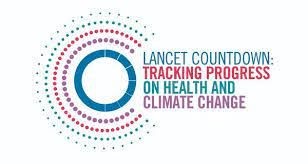
People in every region of the world are increasingly seeing their health affected by climate change. Key trends seen in previous Lancet Countdown Reports are getting worse and exacerbating existing health and social inequities–the 2021 report gives a code red for health.
Check out the Lancet Countdown: Tracking Progress On Health and Climate Change 2021 Report to learn more about the relationship between health and climate change across five key domains and over 40 indicators.
Rock Aboujaoude, Jr., a 24-year-old UF graduate student, will host these Nov 1-12 daily conversations at 7pm on Zoom/Facebook/YouTube. See below for link to register.
Aboujaoude, a UF interdisciplinary ecology master’s student, will be connected live through Zoom from Glasgow, Scotland where the U.N. Climate Change Conferences convenes and will provide live updates each night until the U.N. conferences wrap up Nov. 12. Aboujaoude will be on the ground tracking down delegates to interview and invite to speak at the daily briefings. In the past, he has tracked down Al Gore, Harrison Ford, John Kerry and the U.N. Secretariat.
Few nations are on track to reach the target goals set by the Paris Climate Accords if innovation and change aren’t demanded immediately, Aboujaoude said. Failure to achieve the goals will likely result in more than the suggested global warming limit of well below 2 degrees Celsius. “Pressuring world leaders is the best way to get this done,” Aboujaoude said. “There’s no better time to get the world leaders to pay attention than at an actual climate summit.” Aboujaoude believes the university will pioneer student involvement with U.N. climate conference delegates.
“UF students will be able to participate in a much grander scale than any year previously with the negotiations,” Aboujaoude said. “We can encourage student participation in the largest climate conference that the world has.”
The Paris Agreement works on a 5-year cycle. With the last adoption in 2015, Aboujaoude decided to propose this special event. He also wants to boost involvement now that the U.S. has officially rejoined after former President Donald Trump’s withdrawal in 2017.
Aboujaoude said he hopes to have similar conferences at UF and other U.S. universities in the future. “It’s young people who stand to lose the most at this stage in our life if the climate crisis isn’t solved,” Aboujaoude said. “This is our moment to shine.”
Students as well as non-students can register for the conference and receive a meeting link from the Campus Climate Corps website.
Also follow Climate Central as a great source for the conference:
Check out our guide to next week's UN Climate Change Conference—and see what the outcomes could mean for future warming at 240+ stations across the U.S.
Advancing Climate Adaptation and Coastal Community Resilience
CPO’s newly launched Adaptation Sciences (AdSci) Program has announced 20 new 2-year projects in Fiscal Year 2021 focused on vulnerable U.S. coastal communities planning for the future impacts of flooding in the context of climate change and other stressors.
The competitively selected projects include The Resilient305 Collaborative: Advancing Hyperlocal, Replicable, Impact-driven, Adaptation Science through Resilience Learning led by two FCI universities.
- The PIs will leverage the Resilent305 Collaborative to implement community-engaged research, with an iterative co-design/co-production approach, that advances hyperlocal, impact driven adaptation science to inform a Resilience Learning System replicable in other coastal metropolitan areas. They hypothesize that co-design/co-production of flood resilience actions (e.g., projects, programs, and policies) driven by community priorities, comprehensive metrics and resilience learning will yield cross-sectoral, quality of life benefits of flood resilience investments and in turn, more effective resilience strategies.
- Lead PIs: Tiffany Troxler, The Florida International University Board of Trustees; and Amy Clement, University of Miami
- Co-PIs: Jayantha Obeysekera, Maria Ilcheva, Edward Murray, and Susan Jacobson (Florida International University); William Solecki and Erin Friedman (City University of New York, Hunter College); James Murley (Miami-Dade County); Scot Evans and Katharine Mach (University of Miami)
By Brendan Rivers
President Joe Biden signed a $1 trillion infrastructure bill into law last week that includes billions earmarked for climate solutions.
For reaction to the massive federal investment, I turned to one of Florida’s top climate scientists, Jayantha Obeysekera, director of the Sea Level Solution Center at Florida International University. Professor Obeysekera has worked on sea level rise projections for the Department of Defense and chaired the committee that developed the Southeast Florida Regional Climate Compact.
While he believes the new law will help states like Florida address climate change, he doesn’t think it goes far enough.
“Frankly, all of this funding is probably not adequate. When you look at holistically what is needed, even in infrastructure, it might not be adequate,” he said. “But I think it’s a great first step.”
For the 2nd year, UF students from Architecture, Historic Preservation, and Journalism will participate in the Envision Resilience Challenge. FCI Coordinator, Carolyn Cox, has been working with the ReMain Nantucket team again to provide this opportunity for UF students to collaborate across disciplines and across universities. This year, students will collaborate with other teams from Northeastern, RISD/Brown, Roger Williams, Syracuse, and U Rhode Island in looking at the Narragansett Bay under sea level rise and climate impacts.
Professors Jeff Carney, Linda Stevenson, and Cynthia Barnett will lead students who will all get the chance to travel to Rhode Island, hear from national/international experts on the complex challenges facing RI, present to an esteemed jury of principals in architecture, design, and engineering firms, and share their designs and research to the communities in June. This opportunity will broaden perspectives, enhance collaboration skills, and provide valuable experience engaging with communities and peers around climate adaptation and resiliency.
Stay tuned for updates and follow along with the speaker series.
The Florida Climate Center has released their 2021 year-end annual weather and climate summary for the state of Florida. 2021 saw continued warmth across the state, tying with 2018 as the 8th-warmest year in the instrumental record. 2021 marked the 11th year in a row with above-average temperatures statewide, and 21 out of the past 22 years have been warmer than the historical average in Florida. Many counties recorded one of their top 10 warmest years on record. The statewide average precipitation in 2021 was 56.14 inches. This total ranked 48th-wettest in the instrumental record dating back to 1895. Winter and spring rainfall were below the 20th century average, while summer and fall were above average. Hurricanes Elsa and Ida and Tropical storm Claudette contributed to excessive rainfall across the western Panhandle and parts of north-central Florida.
Also, NOAA released their 2022 State Climate Summaries this month. “These state summaries offer up-to-date, local perspectives on climate in each state. The State Climate Summaries spell out recent local conditions for each state and provide insights about the state’s climate outlook based on historical trends and future projections.”
Read the NOAA Florida State Summary.

On February 14, 2022, NOAA along with other interagency collaborators released the Sea Level Rise Technical Report providing the most up-to-date sea level rise projections available for all U.S. states and territories. The updated data offers projections out to the year 2150 and information to help communities and decision-makers assess potential changes in average tide heights and height-specific threshold frequencies as they strive to adapt to sea level rise. These new and updated projections fill in the gaps in information for some rural and underserved regions.
The Technical Report is the latest product of the Interagency Sea Level Rise and Coastal Flood Hazard and Tool Task Force which includes NOAA, EPA, NASA, USGS, and USACE. Additional support was provided by the U.S. Department of Defense Strategic Environmental Research and Development Program.
Listen to Episode 52 of NOAA Ocean Podcast where two members of the Federal Sea Level Rise Task Force discuss the new Sea Level Rise Technical Report. Find out more information on this report at https://oceanservice.noaa. gov/slr
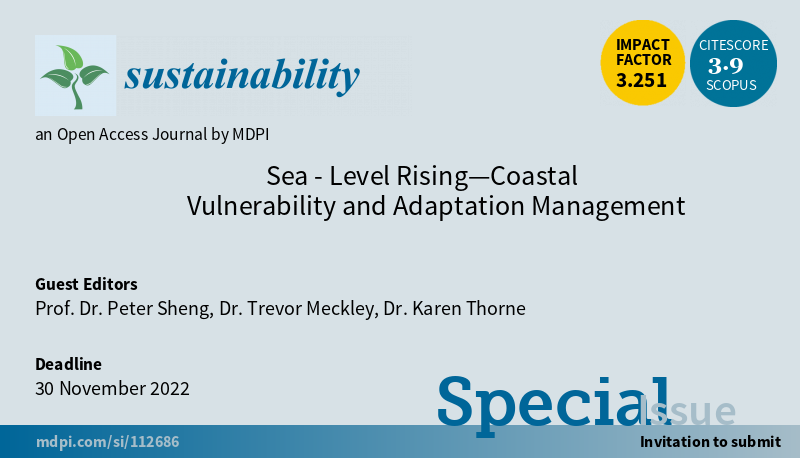
You are encouraged to contribute a research or comprehensive review article for consideration for publication in a Special Issue "Sea-Level Rising - Coastal Vulnerability and Adaptation Management" of Sustainability, an international Open Access journal which provides an advanced forum for research findings in areas related to sustainability and sustainable development. The journal publishes original research articles, reviews, conference proceedings (peer-reviewed full articles) and communications.
Accelerating sea-level rise, compounded with more intense and wetter cyclones and growing coastal development, are expected to greatly increase the vulnerability of coastal communities, critical infrastructures, and coastal resources including wetlands, beaches, and coral reefs which offer protection to coastal hazards. There is an urgent need to develop a new framework and paradigm for coastal vulnerability analysis based on the best available science and a holistic approach which addresses the compound impact of various drivers and their interactions in the remainder of the 21st century. Based on the results of science-based vulnerability analysis, coastal communities can develop adaptation management plans including the restoration of wetlands and coral reefs, the revision of flood management standard and building codes, the development of future coastal flood maps, strategic migration, etc.
Deadline for manuscript submissions: November 30, 2022
Details on the special issue, including guest editors and how to submit manuscripts, can be found here.
New IPCC report does not mince words.
The Working Group II contribution to the IPCC (Intergovernmental Panel on Climate Change) Sixth Assessment Report assesses the impacts of climate change, looking at ecosystems, biodiversity, and human communities at global and regional levels. It also reviews vulnerabilities and the capacities and limits of the natural world and human societies to adapt to climate change.
“This report is a dire warning about the consequences of inaction,” said Hoesung Lee, Chair of the IPCC. “It shows that climate change is a grave and mounting threat to our wellbeing and a healthy planet. Our actions today will shape how people adapt and nature responds to increasing climate risks.”

The U.S. National Science Foundation (NSF) has awarded a $12.8 million four-year cooperative agreement to Florida International University’s Extreme Events Institute to support the design of a national full-scale testing facility capable of wind speeds of up to 200 miles per hour, combined with a water basin to simulate storm surge and wave action.
This Mid-scale Research Infrastructure-1 (MsRI-1 DP) project is formally titled “Mid-scale RI-1 (M1:DP): National Full-Scale Testing Infrastructure for Community Hardening in Extreme Wind, Surge, and Wave Events (NICHE).”The NICHE is intended to become part of NSF’s Natural Hazards Engineering Research Infrastructure (NHERI) – a distributed, multi-user national facility that provides the natural hazards engineering research community with access to research infrastructure that includes earthquake and wind engineering experimental facilities, cyberinfrastructure (CI), computational modeling and simulation tools, high performance computing resources, and research data, as well as education and community outreach activities.
FIU’s academic partners for the NICHE project include the University of Florida, Oregon State University, Stanford University, the University of Notre Dame, the Georgia Institute of Technology, the University of Illinois at Urbana-Champaign, Colorado State University, and Wayne State University. The principal industry partner is Aerolab.
You can read more about this project here.

A team of University of Florida (UF) faculty members has been awarded a grant of $1.6 million to study the impact of climate change in West Africa, the Minerva Research Initiative announced on Friday 24 February 2022. The project, Social & institutional determinants of vulnerability & resilience to climate hazards in the Sahel, was one of seventeen grants selected from 220 applications in this year’s competition.
The research team aims to understand and explain the variations in responses to the effects of climate change in the region. It is comprised of an interdisciplinary group of scholars affiliated with the UF Sahel Research Group, including project P.I. Leonardo A. Villalón, Professor of African Politics and currently Dean of the International Center and Associate Provost, and co-P.Is Sarah McKune (Global & Environmental Health and African Studies) and Renata Serra (African Studies), with contributions by Gregory Kiker (Agricultural and Biologial Engineering) and Steven Radil of the US Air Force Academy.
The three-year research project will focus on the six countries of the Sahel region of West Africa: Senegal, Mauritania, Mali, Burkina Faso, Niger and Chad. These are among the least developed countries on earth according to United Nations rankings, and highly susceptible to the effects of climate change. In the past decade they have also been subject to intense pressures from many sources, including violent extremist movements. Yet the region also shows continued sources of resilience among its diverse populations, drawing on its historical models of adapting to uncertainty.
“Understanding the factors shaping how the countries of the Sahel will adapt to the effects of climate change is of critical importance for the livelihoods of the people of the region,” Villalón notes, “and it also has major implications for the entire global community in our increasingly interconnected world.”
The Minerva Research Initiative, launched by the US Secretary of Defense in 2008, supports university-based social science research aimed at improving basic understanding of the social, cultural, behavioral, and political forces that shape regions of the world of strategic importance to the U.S.
Kathe Todd-Brown, Ph.D., an assistant professor in the Department of Environmental Engineering Sciences within the Engineering School of Sustainable Infrastructure & Environment, has been awarded the National Science Foundation’s (NSF) CAREER award to improve the predictive understanding of soil carbon dynamics by connecting different theories with diverse measurements.
More details can be found here:
https://www.essie.ufl.edu/todd-brown-receives-nsf-career-award-to-predict-soil-carbon-dynamics/
CRIS (Community Resiliency Information Systems) is designed to identify unique resiliency needs by combining biophysical vulnerability to sea level rise, flooding and storm surge as well as socio-economic vulnerabilities at the neighborhood level, so solutions (including access to resources and information) can be customized by neighborhood to ensure equitable resiliency. This unique and interactive resiliency tool combines physical data (including, storm surge, sea-level rise and flooding), environmental hazards (including various environmental justice (EJ) indices) and socio-economic data from the census, with live survey data to map and reveal patterns of risks and highlight specific resiliency issues associated with natural hazards in our area. In addition, sensor data (currently only weather and air quality sensor data) are also fed into the system and displayed in real-time. CRIS, by virtue of being fully online and compatible with smart phone interface, fosters transparency and accessibility of information and comparison across neighborhoods that is needed for informed advocacy and resource allocations to address unique needs communities in the context of climate change and extreme weather events.
A short video overview of CRIS is available here:
https://www.youtube.com/watch?v=FAYikhQrj7M
On Monday, April 4, the Intergovernmental Panel on Climate Change (IPCC) released a landmark scientific report focused on mitigating climate change.
Climate change mitigation refers to actions that slow the rate of climate change by:
· reducing or stopping heat-trapping emissions, or
· removing heat-trapping greenhouse gasses from the air
The Working Group III report provides an updated global assessment of climate change mitigation progress and pledges, and examines the sources of global emissions. It explains developments in emission reduction and mitigation efforts, assessing the impact of national climate pledges in relation to long-term emissions goals.
The IPCC has published a technical summary and a summary for policymakers in addition to the full report.
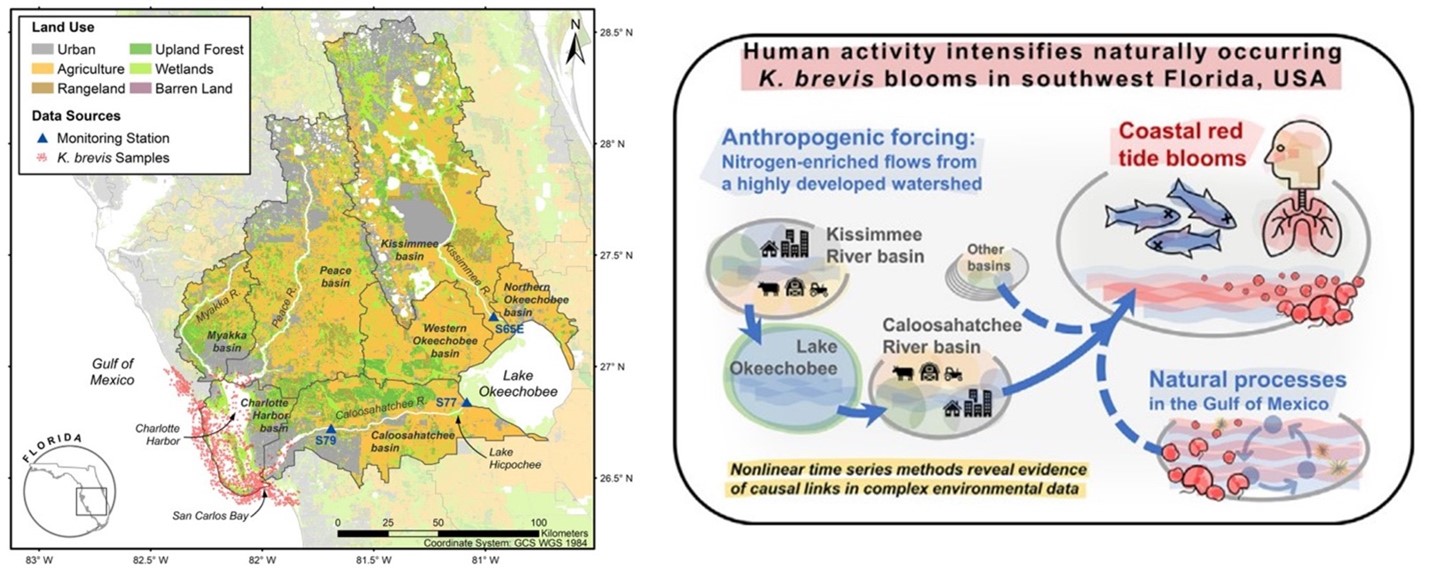
Red tide blooms occur naturally in the Gulf of Mexico, but human activity can make them worse once they reach Florida's coast, according to new research led by research scientist Dr. Miles Medina. The peer-reviewed study, published in Science of the Total Environment, links red tide blooms near Charlotte Harbor to nitrogen-enriched flows from the Caloosahatchee River, Lake Okeechobee, and upstream areas.
"Our study is the first to find evidence of what many have long suspected--that nitrogen inputs from the watershed make red tides more intense and make them last longer," said Dr. Medina.
The results indicate that human activity has consistently played a role in red tide intensification during the past decade, suggesting that we can reduce the severity, duration, and impacts of red tides through management of land-based nutrients and discharges.
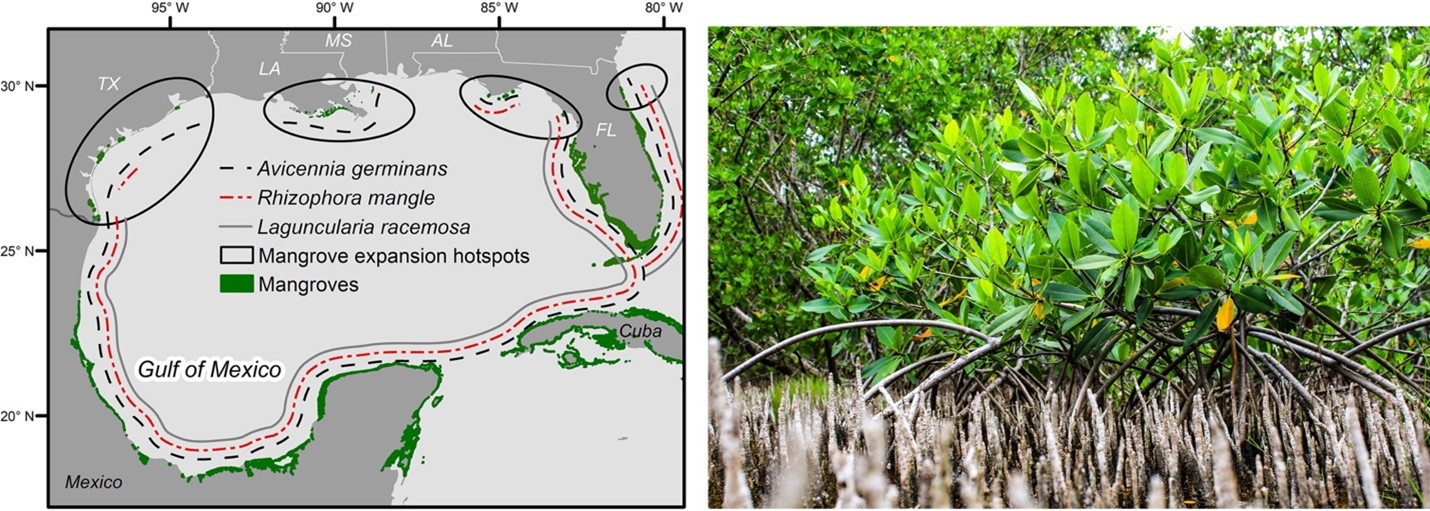
In response to warming winters, mangroves have been expanding and displacing salt marshes at varying degrees of severity in parts of north Florida, Louisiana, and Texas. A paper published in Global Change Biology, led by Michael Osland (USGS) with contributions from 21 coauthors including Mike Allen (NCBS); and Joe Marchionno (UF ESSIE PhD student), reviews the current understanding of impacts of mangrove range expansion on wetland ecosystem services. The authors identify knowledge gaps and research needs related to ecological and societal concerns over mangrove range expansion. While mangrove range expansion can produce beneficial changes to wetland ecosystem services (e.g., improved coastal fish and wildlife habitat), it also can produce detrimental changes to other services (e.g., loss of coastal views, impacts to property values). These service trade-offs are an important consideration for coastal managers due to the scale of their impacts. The paper summarizes the important implications of mangrove expansions given climate change.


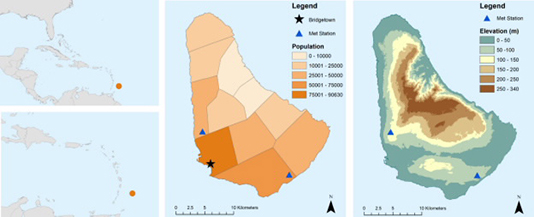
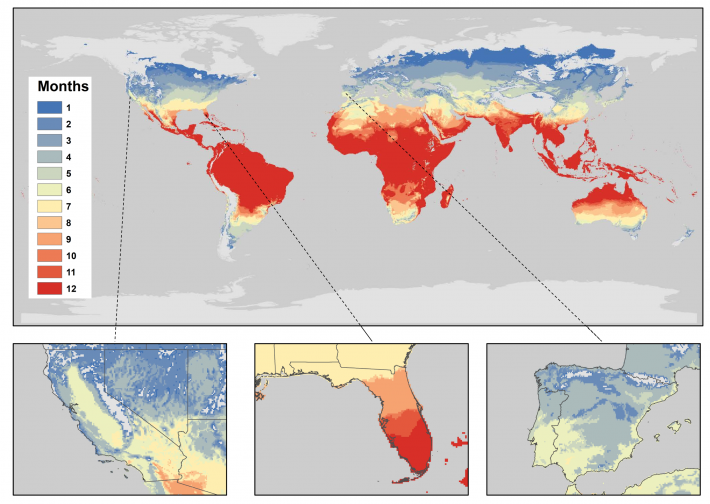 Credit: Taylor RA, Ryan SJ, Lippi CA, et al. Predicting the fundamental thermal niche of crop pests and diseases in a changing world: A case study on citrus greening, Journal of Applied Ecology, DOI: 10.1111/1365- 2664.13455
Credit: Taylor RA, Ryan SJ, Lippi CA, et al. Predicting the fundamental thermal niche of crop pests and diseases in a changing world: A case study on citrus greening, Journal of Applied Ecology, DOI: 10.1111/1365- 2664.13455